Honest Travellers
Honest travel tips & stories


All you need to know before visiting a Maasai Village
A visit to a Maasai village is almost inevitable when travelling to the Maasai Mara. The Maasai (or Masai) are mostly known for the colourful garments and jewellery they wear, their warriors and high jumps, which continue to fascinate tourists.
The Maasai is one of the 43 tribes that make up Kenya’s population, but it can also be found in Tanzania. In fact, the Maasai people know no borders and they can travel freely between the two countries. Many of the Maasai are still semi-nomadic, so they don’t have permanent settlements and move wherever the pastures are better for their cattle where they live in small villages made up of 20-30 mud huts.
While most of their lives haven’t been impacted much by modern civilization, they have adapted to the constant influx of tourists to their native lands and have opened up their villages to tours and visitors.
We weren’t sure whether to visit a Maasai village as part of our safari trip since such experiences often tend to be tourist traps. But after passing by some of these villages along the road to the Maasai Mara National Reserve, which seemed quite authentic, we decided to stop at one on our way back to learn more about the Maasai culture. What we found left us with mixed feelings. Here are some things to consider before visiting.
Read Also: What to pack for a safari in Kenya
Be ready to pay an entrance fee
As soon as we parked in front of the village, which was just outside the entrance to the Maasai Mara reserve, the family chief and their guide greeted us with a big smile. Whether they were genuinely happy to welcome us or just glad to get some money is anyone’s guess. Our Maasai guide was fluent in English and after welcoming us he requested the entrance fee of 25 USD per person, which includes the village tour with welcome dances. We were also allowed to take photos and videos and ask as many questions as we liked.
We came to know that other villages ask for donations above 10 USD per person. The price is somehow related to the popularity of the village. Those next to the road and Maasai Mara’s main gates are usually more expensive.
The money paid is usually used by the village to buy cattle or vegetables from the local market or to pay for other services and commodities.

Forget the BBC documentary
We were expecting something like a BBC documentary, with warriors returning from a successful hunt and women busy with their daily routine. What we found instead was a well-organized show. The men welcomed Andre with warrior songs and dances, showing their jumping skills outside the village fence. In the inner courtyard, the women welcomed Mara with their own love songs.
Curiosity: Andre is 193 cm (6’4″) tall and since he was taller than the tallest family member he was the real attraction!
Afterwards they showed us how to light a fire the old-fashioned way, with wooden sticks which they then tried to sell us for 40 USD. They also allowed us to enter one of their huts, made up of a two small rooms where a family of 6-8 live at a time. One of the rooms is used sleeping and cooking, while the other shelters the calves at night.
At the end of the visit, a quick walk in their souvenir market is mandatory. You are not forced to buy anything but they may put some pressure on you. The basic rule we learnt while negotiating prices in Kenya is the basic principle of Hakuna Matata – no problem. If you show respect while refusing an object or negotiating a price, no one gets upset. The same principle was applied in the village we visited.
The Maasai guide told us plain: “our family members will ask you to buy stuff. If you don’t want to, hakuna matata ”. And that was respected. We refused several items and after the first “no thanks”, they didn’t ask again.

Bits of Maasai Culture
Our guide from Explorer Kenya had already introduced us to some of the most significant tribal customs, but hearing it from the Maasai themselves is somehow different. The Maasai culture is quite peculiar as we learnt during our visit.
- Women do all the hard work, while men only attend to the animals
- Men are allowed to marry as many wives as they like (or can afford); women can have only one husband
- Men have to pay 10 cows dowry for each wife to her family
- Wives shall come from a different village and move to the husband’s village after the wedding
- They used to be carnivore with a diet based on a milk and blood mixture and grilled meat
- Recently they introduced vegetables in their diets but they do not cultivate any
They usually live in the village less than a year because the termites eat the wood structure. Once the huts start degrading, they move the village a little and burn down the abandoned huts to prevent the house spirits to be freed.

Is it worth visiting a Maasai Village?
We enjoyed the company of the Maasai people and their willingness to share with us their culture. They live without electricity and internet and made fun of us when we told them that for many of us westerners “no internet” is a tragedy.
We would recommend seeing this experience as educational, keeping in mind what to expect. Take as much out of your visit to a Maasai village as possible as there is much to learn from different cultures.
What really should make you think is the impact of mass tourism. Families that used to be nomadic turned to be more permanently settled because of the cash income. Whether this is an improvement or an impoverishment of local traditions, it’s hard to say.
It is however saddening to see that modern civilization has exported the urge to gather and possess cash also to tribes that hardly had the need to use it in the past.
You may want to ask your tour operator or tour guide to take you to a more genuine village. However, you should know that they all have agreements with specific villages so it may end up being the same experience.

Share with us your experience
We would love to read about your experience and how you felt while visiting a Maasai Village, whether in Kenya or Tanzania. Leave your thoughts in the comment field below.
Share this:
- Click to share on Facebook (Opens in new window)
- Click to share on WhatsApp (Opens in new window)
- Click to share on Twitter (Opens in new window)
- Click to share on LinkedIn (Opens in new window)
- Click to share on Pinterest (Opens in new window)
- Click to share on Reddit (Opens in new window)
- Click to email a link to a friend (Opens in new window)
- Click to share on Tumblr (Opens in new window)
- Click to share on Pocket (Opens in new window)
- Click to share on Telegram (Opens in new window)
Related Posts

Boat Safari at Lake Naivasha

Eid Holidays: Top 5 Destinations For A Great Eid Break

What to see in Lake Nakuru National Park
Leave a reply cancel reply.
This site uses Akismet to reduce spam. Learn how your comment data is processed .

Experience sustainable tourism, embark on a life-changing journey, and help the Maasai retain their heritage.
Live a deep and authentic cultural experience with the Maasai, a tribe of brave warriors, mighty trackers, and semi-nomadic pastoralists who herd cattle and goats, spear in hand, clad in their bright red robes, and honoring both nature and centuries-old traditions.
Modern ways, the ever-increasing demand for resources and space of a growing population, and climate change have resulted in less land for the Maasai, their livestock, and wildlife, with which this tribe has historically lived in harmony.
Seeking to preserve the authentic Masaai culture for generations to come, while ensuring a sustainable livelihood, the local Masai people are upgrading the ‘cultural village’ launched some 30 years ago into a cultural center. This initiative will not only guide and empower the local Masai, but it will also promote the Masai culture in a sustainable way with a focus on economic benefits for the locals.
Join us on an unforgettable journey. Tour the Masaai Mara Village, stay a night or two, or go on a safari adventure in the Mara with a Maasai guide.
Location : Sekenani just 800 meters from Sekenani main gate on your way to Oloolaimutia Gate, Masai Mara, Kenya.
Email: [email protected]
Tel: +0719125853
Maasai = People who speak maa
One of the very few tribes who have kept most of their traditions, culture, and lifestyle virtually unchanged.
Maasai Village Tours
Visiting the Maasai Village is a magical experience that will take you back in time
Join us on a tour to our Masai Mara Village and Cultural Centre and
- Learn about daily life in the village for men, women, and children
- Socialize with villagers and discover Maasai traditions and customs
- Enjoy a personalized experience with a Maasai guide
Dominating tribe among over 50 in Kenya
Semi-nomadic and pastoral, the Maasai live by herding cattle and goats.
Traditional Accommodations
Take your immersion into the Maasai culture to a whole new level: Stay with us!
- Stay with the Maasai for a day and a night (accommodations)
- Go on a game drive
- Walk with the Maasai women to go fetch water
- Cook with them and eat their delicious food
- Learn their dances
- And go to sleep to the sounds of the African bush.
Maasai Mara Safari
Experience the thrilling wildlife of the masai mara with africa's bravest hunters as your personal guides.
Email Address
Preferred date and time
Preferred language for the visit
Preferred accommodation Preferred accommodation Cottage Tent
Number of persons
The Masai Mara in Kenya is nature's epic masterpiece.

A little bit about Masai Mara
Rolling hills, sprawling savannahs, dramatic river crossings and of course... more wildlife and adventure than any movie could ever portray. Welcome to the Masai Mara, home to the lions of ‘Big Cat Diary’, temporary residence of the ‘Great Migration’, mighty Maasai warriors and some of the most luxurious safari lodges on earth.
The Masai Mara features a stunning kaleidoscope of wild and rugged landscapes, warm and welcoming people and an exciting array of creatures – big and small. World famous for hosting the epic Great Migration, the Masai Mara welcomes 1,5 million wildebeests onto its sprawling savannahs each July through October. The Masai Mara National Reserve and conservancies are brimming with life and offer safari travellers a wide variety of activities to choose from. Whether you take to the skies for a high-flying hot-air balloon adventure at sunrise or hit the road for a 4x4 safari, you’re sure to leave the Masai Mara with unforgettable experiences and lifelong memories.
Going on a Masai Mara safari
Part of the fun of going on safari is planning your safari. We’ve been there... and know how it feels. As avid travellers we can imagine you have loads of questions while planning your trip to the Masai Mara. Very few places on earth are as unspoilt, adventurous and authentic as the Mara eco-system.
Reading up on the Masai Mara, finding out what you might encounter, exploring your accommodation options... we've done most of the work for you and created this site to help you find all the answers to any questions you may have. To top it off, we've brought together a top-notch collection of Masai Mara safari lodges and camps for you to choose from. Naturally, we're only an e-mail or message away if you need a little extra help planning your safari.

About the Masai Mara
Known as one of the world’s most famous wildlife areas or ‘the world’s eight world wonder’, the Masai Mara has endless plains, breath-taking vistas and abundant wildlife. Learn more about the Masai Mara here.

Masai Mara special offers
Dreaming of the perfect safari holiday? We’ll help you find your way while planning your trip and provide you with a selection of the best available deals. Check out our latest Masai Mara special offers and discounts.

Getting to Masai Mara
Whether you’re arriving from far, far away or travelling to the Masai Mara from a destination in the region. We’ll guide you through your options for getting to the Mara and for getting around once you’re here.
As newbie safari travellers, we were blown away by our experience of the Conservatory - the animals in abundance; the landscapes; the people; the smells and sounds.
It was an amazing experience to actually see the river crossings, that we had seen so many times on TV during the wildebeest migration.
We saw a leopard on a tree and we were lucky enough to watch four lionesses and three cubs eating a fresh hunt. In the evening safari we were able to explore a massive variety of hippopotamus and a crocodile.

Masai Mara lodges & camps
The Masai Mara is rough and rugged, however you don't have to rough it during your stay. Eco-chic safari lodges with four-poster beds, sundowners with your favourite G&T and infinity pools overlooking the African savanna await.
We’ve selected a variety of warm and welcoming Masai Mara safari lodges and camps for you to choose from during your stay. Each of the accommodation options we’ve selected is known for offering premium safari activities, first-class accommodation and every creature comfort you could wish for during your stay.
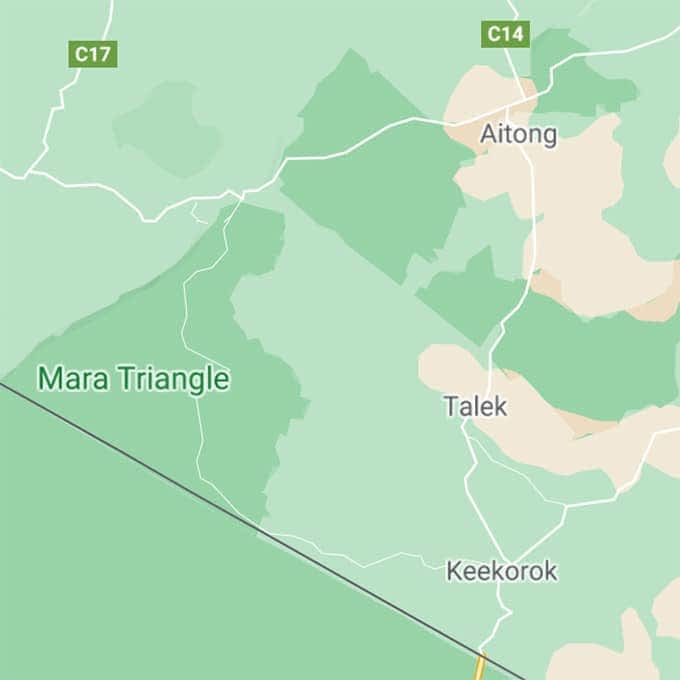
All accommodations in Greater Masai Mara
Browse all camps & lodges
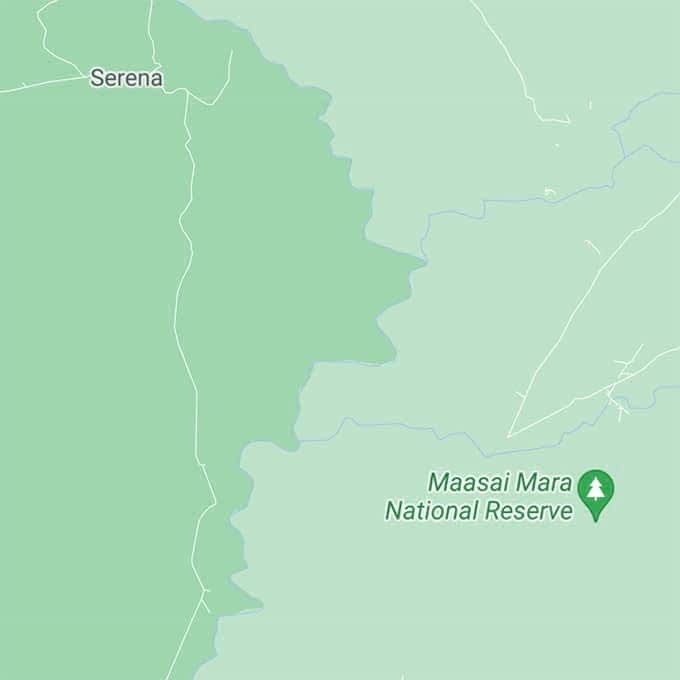
National Reserve accommodation
Browse Masai Mara NR accommodations
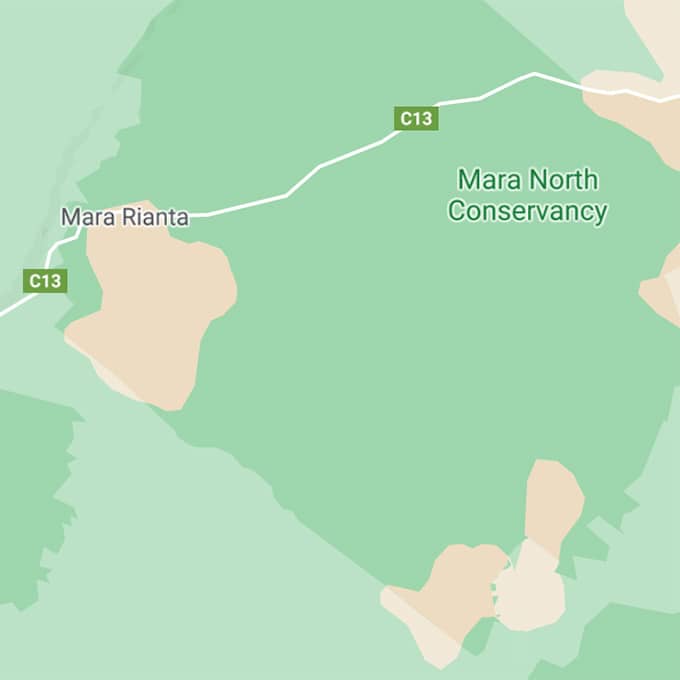
Mara conservancies accommodation
Browse conservancy lodges & camps
Masai Mara lodges we love
We would like to share a few accommodation options with you for your stay in the Masai Mara. Our safari lodge options come in a variety of price ranges, giving you plenty of possibilities to find the right Masai Mara safari camp for your travel budget.
Keep in mind that the following are simply suggestions. We offer tailor-made safari experiences and look forward to creating just the right mix of Masai Mara safari accommodation and activities based on your personal preferences. We look forward to helping you create the bespoke Masai Mara safari of your dreams.
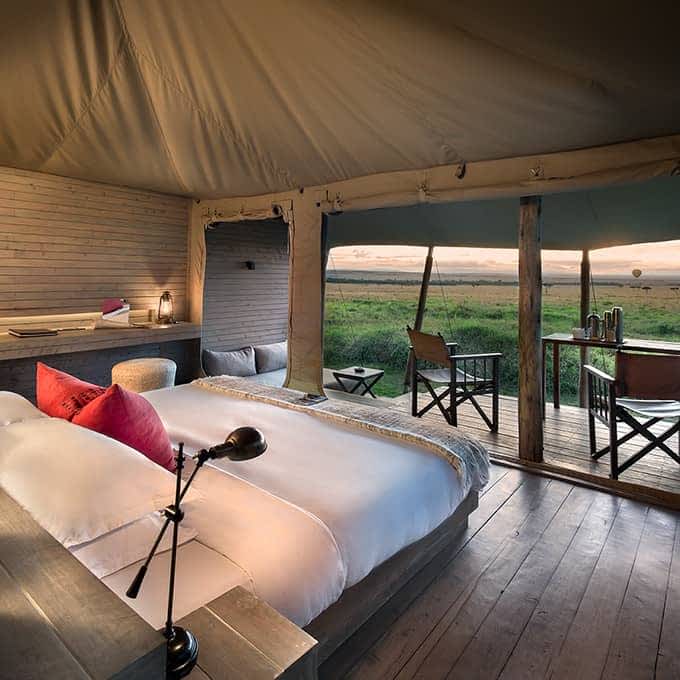
Kichwa Tembo Tented Camp
lodge location Mara Triangle
Kenyan hospitality meets Maasai-inspired luxury on the lush green banks of the Saparingo River. &Beyond Kichwa Tembo Tented Camp lies on the edge of the Oloololo escarpment, where riverine forest meets the sweeping plains of the Masai Mara.

from US$ 435 per person per night
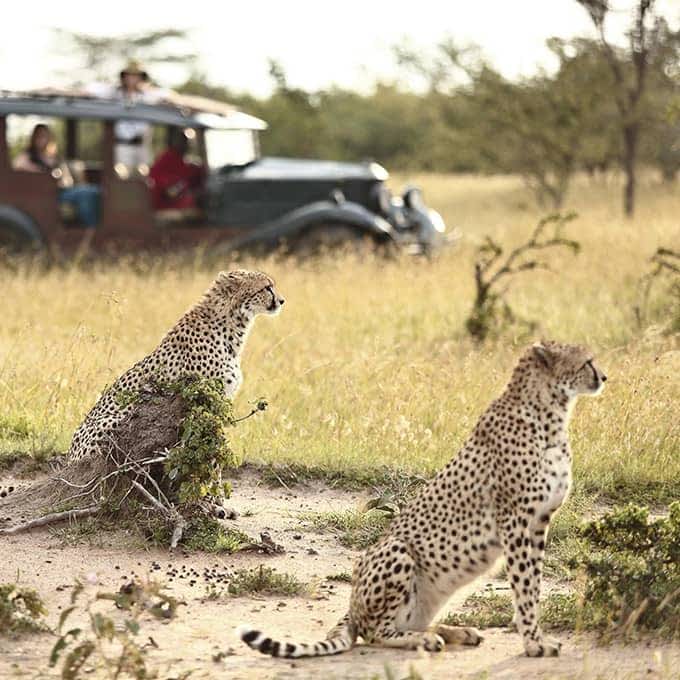
Cottars 1920s Safari Camp
lodge location Olderkesi
Cottar’s 1920s Safari Camp offers guest vintage luxury at its very best. Cream-coloured tents decorated in 1920s epic safari style, professional Maasai safari guides and above all a sense of elegance and class - this classic Kenyan safari camp has it all.
from US$ 1,059 per person per night
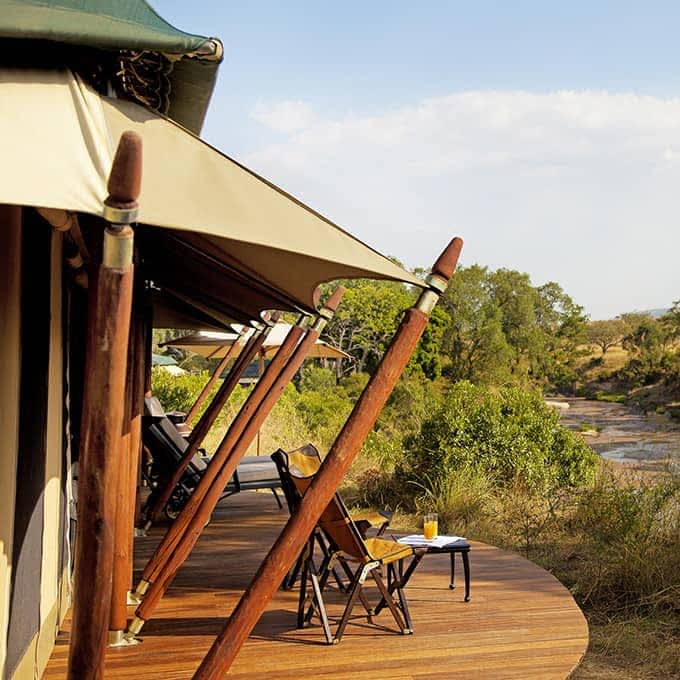
Elewana Sand River Camp
lodge location Musiara Sector
Ideally situated in one of the most remote parts of Masai Mara National Reserve, Sand River Camp pays homage to romantic 1920s safaris. Its design reminds guests of the many African adventure themed Hollywood movies created in that time period.
from US$ 670 per person per night
There were lion cubs galore, a baby zebra born in front of my eyes, pretty much everything an avid photographer could hope for.
The Maasai people were extremely welcoming, and were there to make sure our experience was nothing but the best. We will definitely be back.
The Big 5 and more - giraffes, zebras, hippos, lions with their families, cheetahs and hundreds of wildebeests - no shortage of amazing game sightings every day...
Masai Mara highlights
The Masai Mara is a dream come true for everyone who ever watched ‘Out of Africa’ and longed for the adventurous, romantic nostalgia of an African safari in the wild. The Great Migration, big cats and Maasai warriors await.
The Masai Mara is a photographer's paradise. This region is known for pristine riverine forests, dramatic towering escarpments, stunning sprawling savannahs and of course... all the creatures, big and small, that roam the land. Add a visit to a Maasai village to your stay for a cultural immersion and gain some insight in the day-to-day life of your hosts. For an extra special birds-eye view of the African plains, take to the skies during a hot-air balloon safari. When it comes to crafting the safari of your dreams, the sky is the limit.
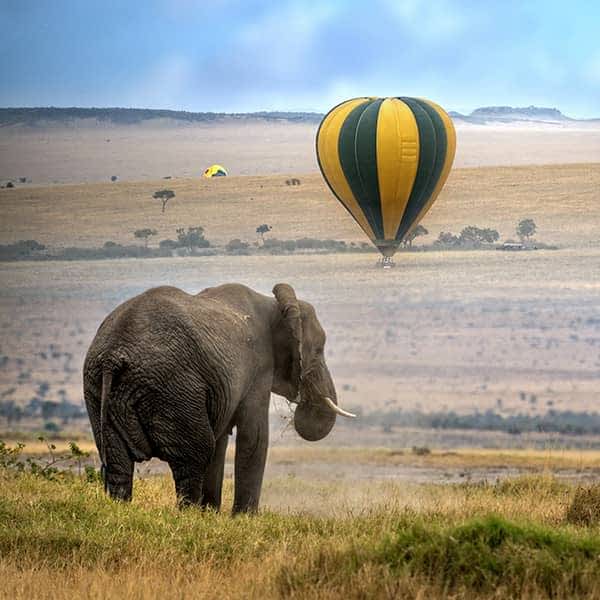
Balloon safari
View golden plains from above
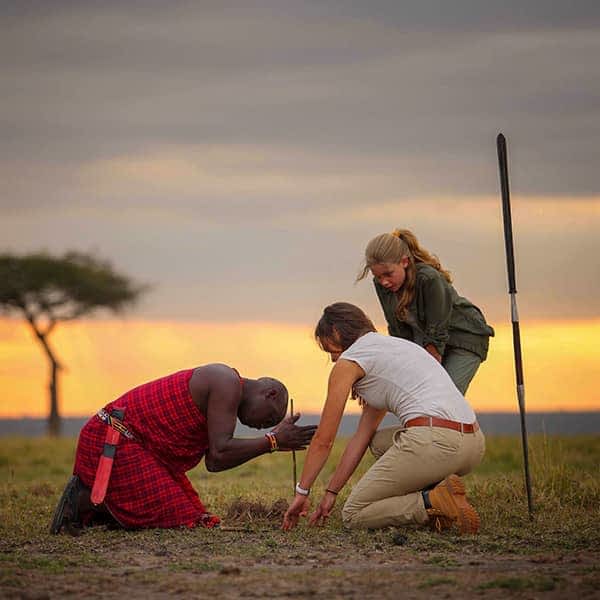
Maasai people
Extraordinary cultural meetings
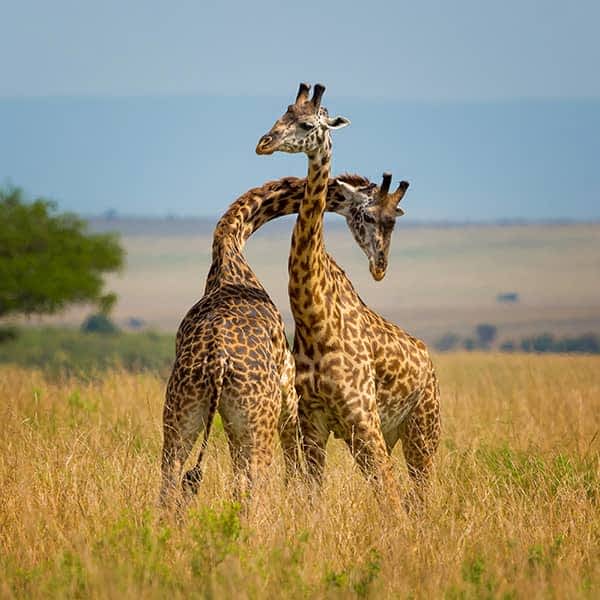
Exhilarating wildlife
Wildlife up close and personal
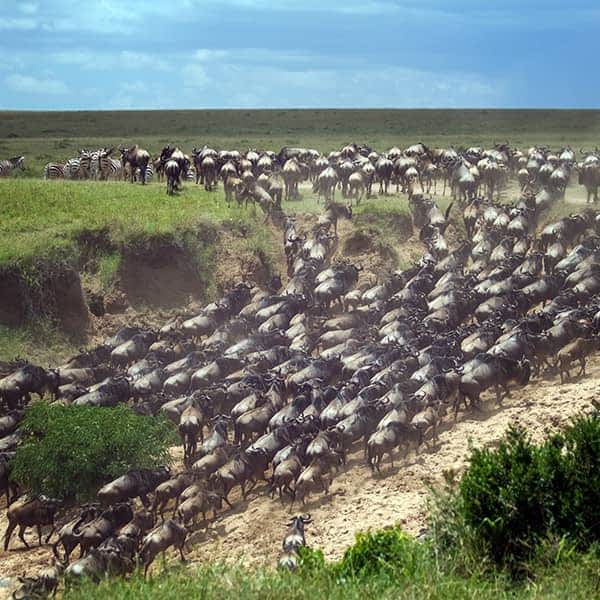
The Great Migration
Wildlife spectacle in the Masai Mara
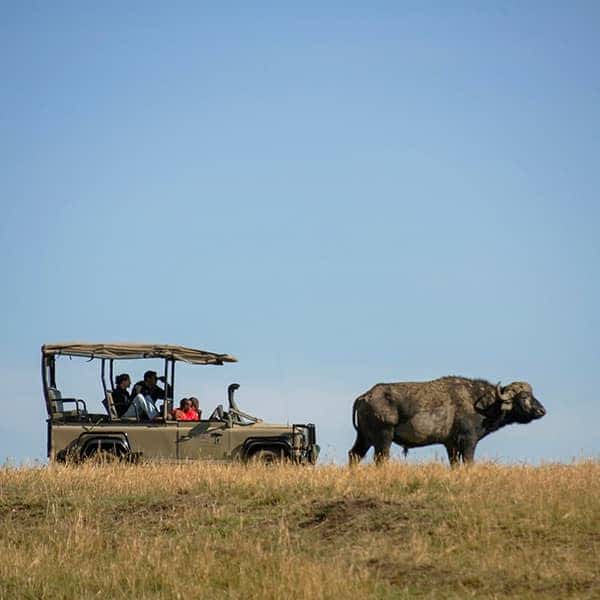
Safari activities
Drive, walks & more
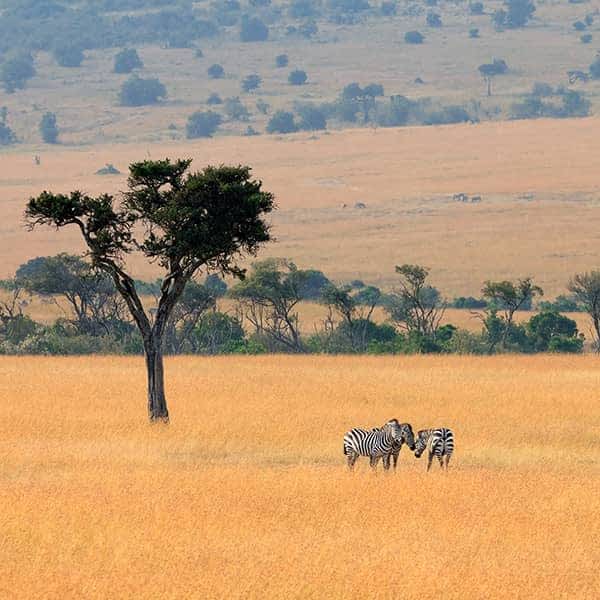
Masai Mara National Reserve
Kenya's premier wildlife reserve
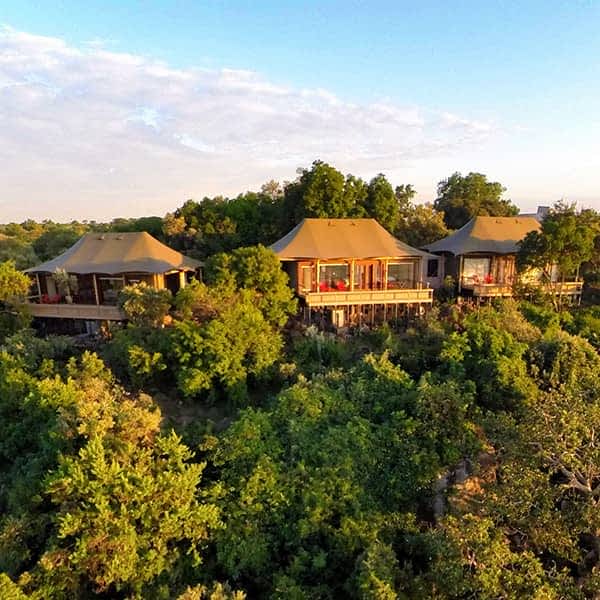
Luxury accommodation
A luxury safari home from home
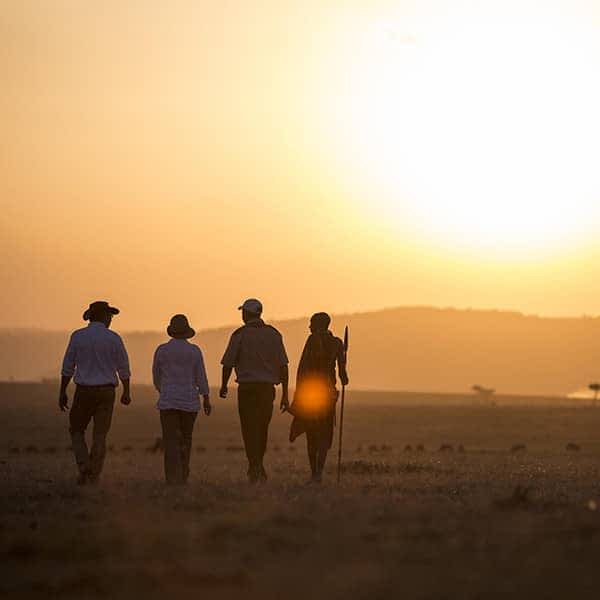
Mara North Conservancy
Enjoy the perks of a conservancy
Conservancies in Kenya are the way to go; protecting the extraordinary wildlife whilst giving the local community an income, together with education on the interaction between the two.
Wonderful area for wildlife viewing. Having been there twice both times were awesome experiences! Will return again.
The highlight of our trip to Mara was seeing the migration at the Mara river. A once in a lifetime experience to see the Wildebeest migrating. An amazing scene of nature it was.
Masai Mara video
The best way of understanding what the Masai Mara and its conservancies are about is by seeing some thrilling footage from the area. Watch this video to experience Kenya's Masai Mara, its splendour and to meet some of our celebrity wildlife species.
Be careful, after watching this video you can be sure that you want to travel to Kenya. Today.
We saw 8 lions in one drive, and a hippo pod being circled by a dozen crocodiles that launched into the water, trying to get the baby hippos in the center of the pod. Wow!
I was fortunate that when I was recently in the Mara North Conservancy there were so few tourists. I saw plenty of wildlife. The sightings of big cats were especially good.
The Mara Triangle is the most beautiful, lush area of the Masai Mara. Loads of elephants and all types of wildlife without all the land cruiser traffic found in other areas of the Mara.
Send your enquiry
We hope you have found all information needed to decide that the Masai Mara in Kenya is the perfect place for your next safari adventure. Still have questions? Or maybe you would like some more specific information about the different lodges? Please fill in the contact form and we will get back to you soon!
- Masai Mara National Reserve & conservancies
- [email protected]

What to Know Before a Visit to Maasai Village in Tanzania

Meeting Maasai tribes is on many people’s bucket list after seeing photos of Maasai warriors jumping high in the air, with the African savanna as their backdrop. Most safari companies offer a stop in a Maasai village in Ngorongoro Crater, promising a wonderful experience.
Wearing their traditional red robes with elaborate beadwork and bells, the Maasai are the most known of all nomadic tribes out there.
Naturally, I wanted to see the Maasai village and meet some of them on my visit to Tanzania. However, a lot of fellow travel blogs and travelers on TripAdvisor described their experience as ‘not worth the visit’, ‘too expensive’, ‘not authentic’, some even called it a scam.

Maasai performing traditional dances
The more I read up on the Maasai, the more confused I got. There was so much contradicting information online, that a list of questions about the Maasai was piling up quickly…
While I can only speak from my experience only in Tanzania, not in Kenya, here’s what I’ve learned on the spot and based on further research.
Who Are the Maasai?
Maasai used to be one of the semi-nomadic tribes who settled in eastern Africa. After the 1904 and 1911 treaties, the governments (including British) evicted the Maasai in order to create wildlife reserves. Amboseli National Park , Nairobi National Park , Maasai Mara , Samburu National Reserve , Lake Nakuru National Park and Tsavo in Kenya; and Lake Manyara , Ngorongoro Conservation Area, Tarangire, and Serengeti National Park in what is now Tanzania.
Maasai used to rely on their livestock cattle, feeding on milk and blood extracted in a traditional way, without killing the actual animal. Over the years, Maasai started cultivating maize and cabbage – firstly introduced to the Maasai by displaced WaArusha and WaMeru women who were married to Maasai men.
While the Maasai resisted the sedentary life, the land privatizations and park boundaries forced them to adapt their lifestyle to rules enforced by new laws. Their land has basically been taken and converted into national parks. Since the Maasai weren’t hunting for big game animals too often, they were allowed to stay in Ngorongoro Conservation Area.
For the Maasai staying in Ngorongoro Conservation Area had its consequences. Because of the area’s protected status, Maasai aren’t allowed to hunt at all. Until recently they also hadn’t been even able to cultivate anything until the ban was lifted. Now they can only have their livestock in certain areas.
Some Facts About the Maasai, That Are Often Perceived Wrong:
- They were never hunters for meat, they had their livestock. They live among wildlife and only occasionally used to hunt for lions in a form of sacrifice.
- That said, they were never vegetarian either. They drink cattle’s blood and milk and occasionally eat cattle’s meat.
- Maasai marriages are polygamous, with a man being responsible to provide for all his wives.
- Maasai kids go to school. They aren’t uneducated.
- These days the Maasai can’t sustain themselves without the money. It’s sad, but true that many tribal communities now depend on tourism.
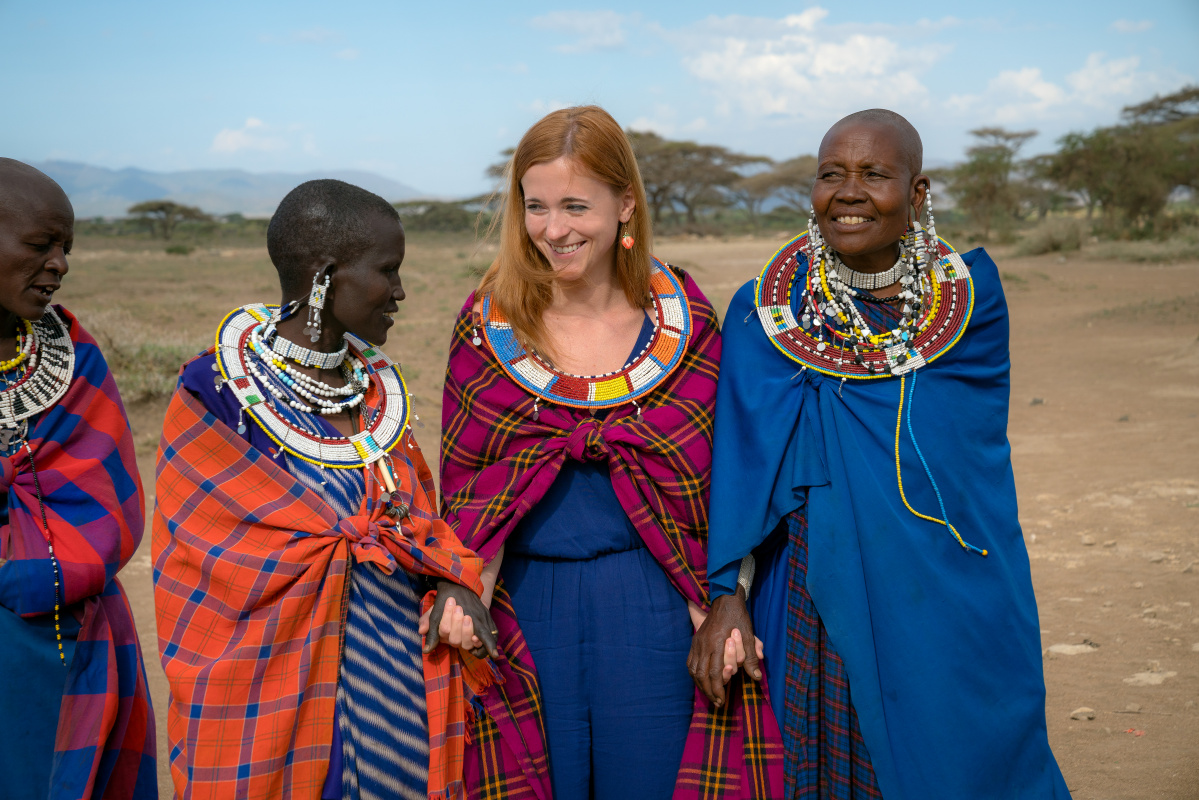
Meeting Maasai in Tanzania
I first met some Maasai during my stay at the Four Seasons Serengeti. They were big, tall men, always with a giant smile on their faces, patrolling the property from wild animals and escorting the guests after dark.
This is also when I found out about the Maasai Women Development Organization that, among other functions, provides work for them to support their families.
I knew straight away that over the years the Masai culture has slightly evolved and many of them leave the traditional lifestyle behind. Those I met there were obviously employed by the hotel, making a regular salary, just like any other employee. They’re not being exploited there.
When I left Serengeti I stumbled upon a group of three young girls hanging out by the entrance to the national park. They were selling bracelets but had to hide from park rangers, as apparently, this wasn’t legal. The girls weren’t pushy though, I definitely didn’t mind.

Visiting Maasai Village in Ngorongoro Crater
When our guide asked us whether we wanted to visit the village where those girls we met lived, we immediately said yes. However, we were told that it will cost us about $50 for a visit.
Many visitors, ourselves included, don’t expect to pay for a visit to someone’s house, right? However, in Maasai’s case, we were asked for money. We paid the fee and entered the village after a warm welcome in perfect English from the village chief.
They dressed up with their traditional clothes and we danced with them for a while before proceeding to see their houses.
Dances were performed with elements of what Maasais are known for: the jumping.
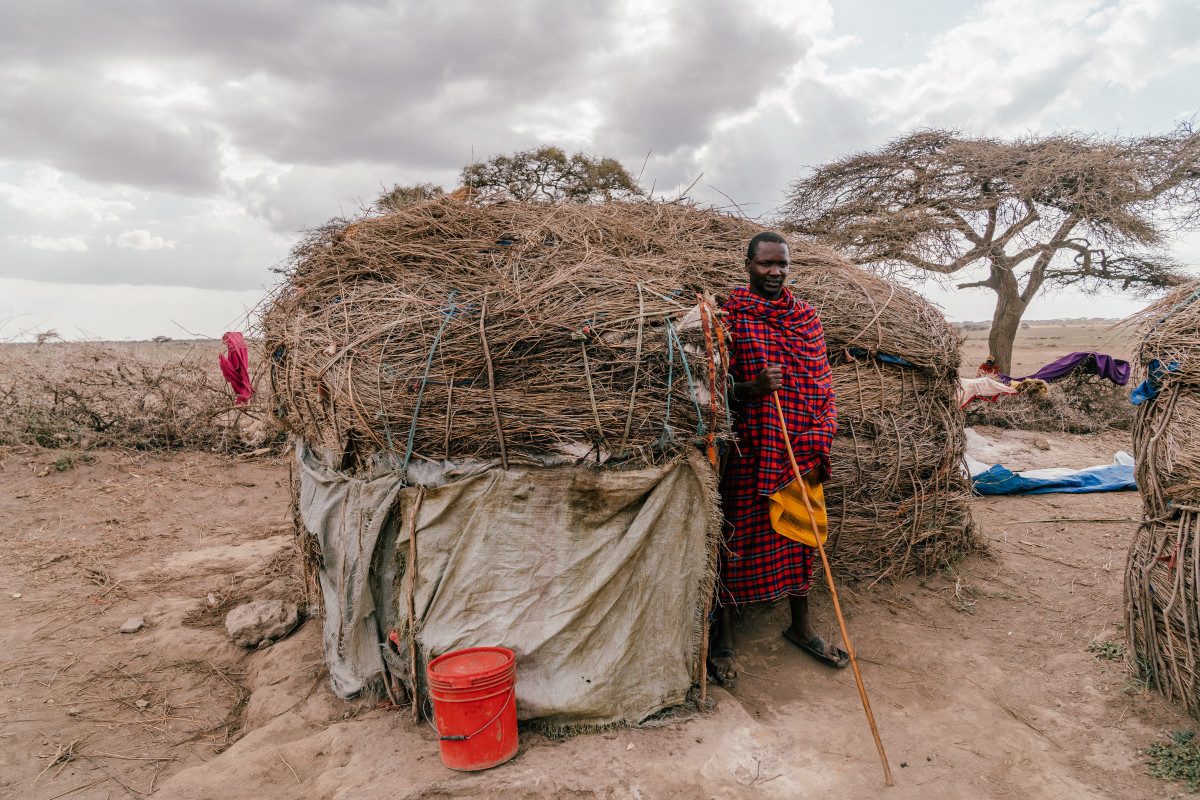
Maasai House
Before we even had a chance to see anything we got taken to the middle of the village and tables full of souvenirs to buy. The chief pressured us to buy something and while we liked some stuff, they were insanely expensive.
We decided to give up on saying we actually don’t need anything and bought a carved warthog for $40 after haggling for the price a bit. It now lives on the TV stand.
We then saw a traditional house built out of mud and clay. One home is for each family, which consists of the women and her children.
When we entered, barely fitting all three of us including the guide, we got welcomed by the smoke from the fire used to cook water and food. There is a hole in the roof to let the smoke out, but it was very dark.
We got introduced to a house owner – a woman sitting on the bed, holding a sleeping baby in her arms. We were told the baby is sick.

School in Maasai Village
Following, we were taken to pre-school were kids sang a song to us. I actually highly doubt it was an actual working pre-school, but rather a place where kids gathered for the day when visitors were about to show up.
At a chalkboard, there was a bunch of numbers and random words written.
Are These Maasai Villages a Tourist Trap?
We left the village slightly puzzled, which led to two important and controversial questions:
- Is this even authentic, or a tourist trap?
- Are these tourists visiting ethical or exploitative and therefore are the Masai suffering from western influences?
It was pretty obvious that this village was clearly tourist-oriented. In fact, many of the villages are apparently constructed just for tourists. This is when we started asking locals questions about how does it work.

Living with their stock.
It turned out that these villages aren’t just there for our entertainment. It’s the way they live. In fact, each tribe is permitted to spend a year at a ‘tourist’ village and make the money they need for the year.
After when they swap the establishment with another tribe and move into a regular Maasai village, far away from any tourists.
If they don’t make the money they need for the next year, they need to send the men to work far away from their families, in order to support the village.
Is Tourism Harmful to the Maasai?
Are tourists destroying the way they live? I think tourists are only a side-effect of what the government has done. The government pushed them out of their lands. It’s because of the government, not tourists, that they’re not allowed to grow food, so they need to buy their own corn.
Opening the village for tourism it allows their tribes to generate the income needed to survive. I’m talking not only about food, but also medicines (there are no medical facilities in the area), clothes or simply means to send their kids to school.
It doesn’t only happen in case of the Maasai, but also villagers in Rwanda . Thanks to tourism they can actually sustain themselves.

Maasai working at Four Seasons Serengeti
If you think about it, who performs traditional country dances dressed in traditional clothes from the past on a daily basis in Europe for instance? It is a cultural performance. These days Maasai are starting businesses and increasingly taking over the tourism industry in their region.
Is this change in this Maasai lifestyle bad? Not in all aspects. Thanks to education and laws it’s illegal for the Maasai to perform FGM (Female Genetic Mutilation), what causes fewer girls running away from their villages and families. On top of naturally, obvious mutation.
It’s basically a female genital cutting, that causes difficulties urinating, pain, kidney damage, and sexual pain . It’s often performed without anesthesia by someone with no medical training, using instruments such as knives, scalpels, scissors, glass or razor blades.
I actually had guts to ask the chief of the village whether they know what FGM was and if they do it, but he quickly said no. He said it still happens in Kenya, but not in Tanzania from what he knows. Even though it used to be deeply ingrained in Maasai culture.
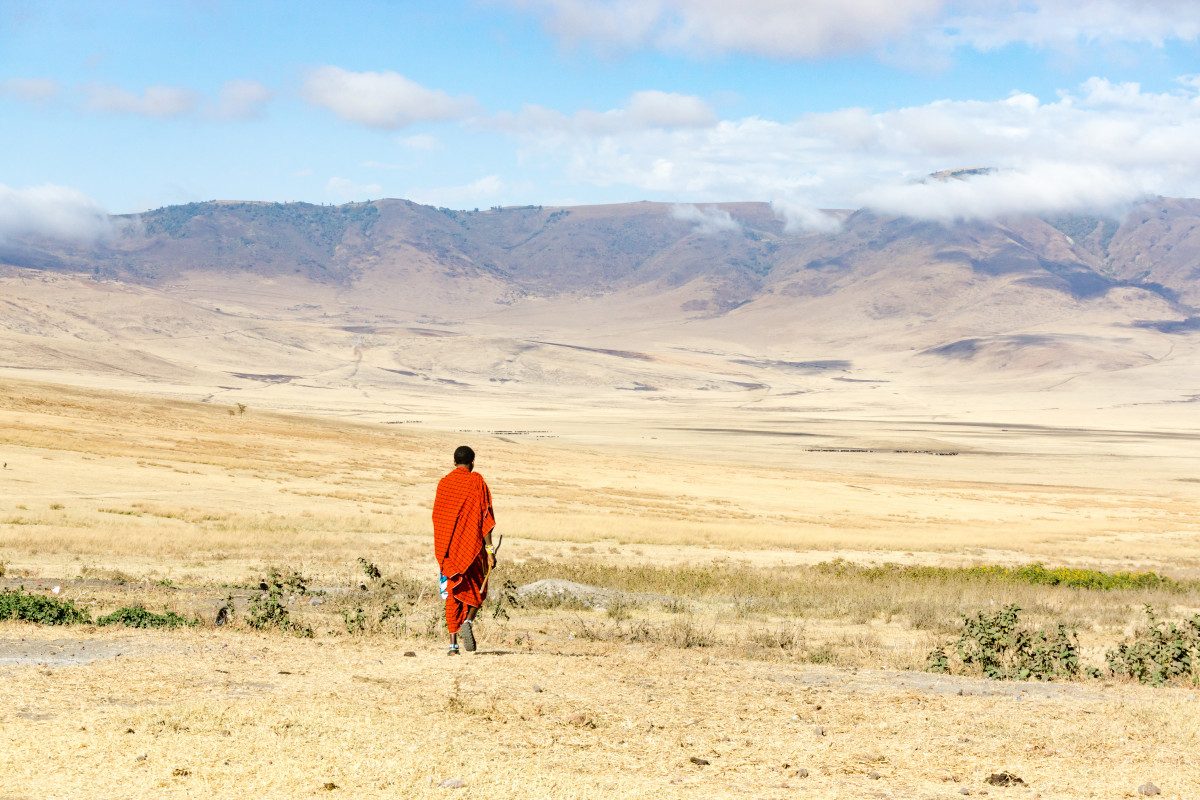
Without any options Maasai can go and find work at some of the hotels, like the Four Seasons Serengeti, many prefer to stay in the village with their families. Having to find work outside of the village takes them away from their families.
It may not be ideal, but perhaps in some ways, this type of tourism is helping to preserve traditional cultures. Especially since the Maasai aren’t always able to make money in other ways.
And one thing to remember is that these people have not been forced against their will to open their villages to tourists. However, respectful – these people still live there and it’s their home
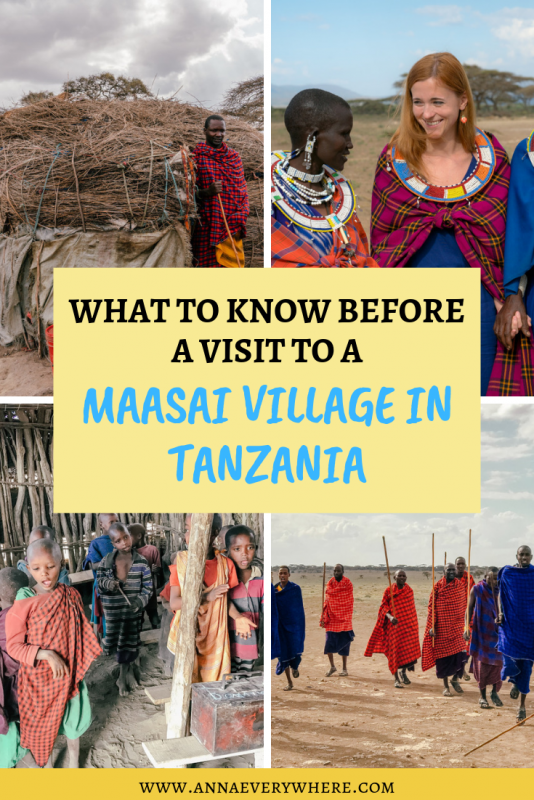
Share this:
Notify me of new posts by email.
Sunday 1st of January 2023
Worst experience ever visiting Maasai Village. They are thieves with no boundaries.
Tuesday 2nd of August 2022
I went in February of 2022 with a small group form Overseas Adventure Travel and had an excellent experience. We did not have to pay a fee. There were crafts for sale, at slightly higher prices than elsewhere, but we weren’t pressured to purchase. We all did buy things, however; after spending a day with the women, we wanted to support them. We spent most of the day, got to see inside several of the bomas, watched the women thatch a roof, helped patch the mud on a boma, watched them weed a field of greens, danced with them, and then participated in a discussion of FGM. While it is illegal, it does still happen in some villages. We were able to ask questions, and the women explained why it was culturally significant. One of the women had performed the “surgeries.” It is less important to the younger generations now that Swahili is the National language and there is intermarriage between tribes. Education has helped everyone understand why it’s a terrible practice. It was an amazing day.
Sunday 3rd of March 2024
@Stacy Murphy, great points! Thanks for your perspective.
Sunday 2nd of July 2023
@Marianne, great response - who did you do your tour with?
Stacy Murphy
Tuesday 17th of January 2023
@Anna Karsten, this is a great post. :) We just got back from our month-long Africa trip and yes, we visited the same village. I loved it. It's all a matter of perspective and attitude. Is it a "scam"? Maybe. Is it over-priced? Perhaps. But was it an informative and enjoyable afternoon? ABSOLUTELY. I loved seeing the bomas and learning about how they're built by the women, and the kids in the school room singing to us was one of the highlights of our trip. Everyone in the village was very kind and engaging and yeah, I did buy many overpriced trinkets because I was happy to help support the village. We also made an additional donation to the school fund... so if our $300 American dollars can help even one child attend private school then we are thrilled to have made the tiniest contribution. I think it is fine that they have "tourist" villages. Would people want strangers/tourists tromping through their homes all day????? I think not. We are curious looky-loos so it makes perfect sense to me. If you are afraid it's a scam then don't go and don't buy anything or donate to the school... but sadly you'll miss out on learning more about their tribes and culture and dancing with them and seeing their dress and hearing their songs. That's a shame. Right?
Anna Karsten
Wednesday 3rd of August 2022
It's not always bad :) , but it's just not an authentic experience like they paint it to be (for example, if you really go remote there's no such thing as selling anything to tourists). You paid a fee but it was simply included in your tour, they might just handle fees very quietly but the Maasai do get paid.
Saturday 13th of March 2021
Hello - While I did see a few Maasai villages and roadside honey salespeople going through Tanzania, my interaction with the Maasai in December 2020 was quite different. I befriended a security guard at my small hotel on Zanzibar and we agreed to keep in touch via WhatsApp. Want to guess what happened as soon as we got home? Yes, the money requests began pouring in. Long stories of pay cuts, then being laid-off. Exact amounts requested ($2600 USD). So, I emailed the hotel only to find that none of that was true, and that the Maasai man still worked there, and that they tend to collect contact information from westerners on a regular basis to exploit later. I was bummed, because I make friends all over the world. It was like this throughout Tanzania this trip, and I can’t say I wasn’t warned: the hotel owners, the European tour operators, and South Africans on holiday we encountered were especially bitter and embarrassed by it and suggested we not even speak to them. I personally can’t be that cold, but I take their point. Just kinda sad. Great country though. Saw Zanzibar, Arusha, Kilimanjaro, Karatu, NCA, Serengeti - no masks required!
Saturday 12th of December 2020
Excellent post and information ! Thank you
Friday 2nd of October 2020
Hi Anna, great post! Could you share some details on your tour guide, as I’m thinking of visiting very soon.
I used a company called Soul of Tanzania :)
- &BEYOND LODGES
- South Africa
- Flying solo
- With my partner
- With my family
- Adventurous
- Responsible Travel
- Private Travel
- Slow Travel
- TRAVEL TRADE PORTAL
- MANAGE YOUR TRAVEL BOARD
Maasai cultural visit
Take a glimpse into traditional masaai life in the mara.
- Indian Ocean Islands
- South America
- Amboseli National Park
- Chyulu National Park
- Kenyan Coast
- Masai Mara National Park
- Meru National Park
- Rift Valley
- Samburu National Park
- Tsavo National Park
Immerse yourself in authentic Maasai culture as you visit a traditional village, accompanied by an English-speaking guide who lives there himself.
Find yourself in the midst of the daily hustle and bustle of local life as you witness the daily rituals of the Maasai. Once you have drunk your fill of this authentic cultural experience, you can choose to browse through the Maasai Craft Centre and purchase artefacts made by the people you encountered. All proceeds from this go directly to the community.
Living a semi-nomadic lifestyle, the Maasai tribe has modernised in some ways but still adheres to many aspects of their traditional culture. Established as fierce warriors, their lively cultural dance, vibrant clothing and beautifully crafted handiwork are recognised worldwide.
The Maasai used to move nomadically with their herds to abundant lush pastures but these days they have built permanent huts or bomas and prefer to stay in once place. They are pastoralists and cattle is essential to their way of life. A man’s success is measured by the number of cattle and offspring he has. As great a status and show of wealth the cattle are, they are also a vital food source. This glimpse of authentic Maasai culture is a fascinating experience of an ancient way of life that still flourishes today.
TAILORMAKE YOUR STAY
Talk to one of our travel specialists to tailormake you stay to any of our destinations
Places to stay
Stay here to enjoy this experience, tailormade tours, enjoy this experience on these inspirational journeys, more experiences you may also be interested in…, i dream of travel that leaves our world a better place.
You’re just 5 easy (and fun) steps away from creating your ideal Travel Dream Board.
Step 1: Start with where
Step 2: Clarify what kind of traveller you are
Step 3: Tick off those grand bucket list experiences that will fire your imagination
Step 4: Log in to create and add to your Dream Board
Step 5: Share & start dreaming
Leaving our world a better place for years
Discover the impact legacy that your travel with &beyond is driving. just as the un’s sustainable development goals have been a touchstone for our vision 2020 group-operation sustainability audits, so they continue to guide and underpin our ambitiously scaled vision 2030 goals., we're sorry but this site doesn't work properly without javascript enabled., please enable it to continue., privacy overview.
.png)
Community based eco tourism
Support local & Responsible travel with us
Oseki Mara Camp
Experience local hospitality, simplicity & authenticity.
Scroll Down
Discover a local Maasai Village Learn about the Culture, traditions & history All when Travelling Sustainably
Authentic Travel:
Experience a Maasai Village Visit in the Sustainable Masai Mara
Welcome to an unforgettable journey of authentic travel in the Masai Mara, where you can immerse yourself in the vibrant culture of the Maasai people and make a positive impact on their community. At Oseki, we believe in sustainable tourism that supports local communities while providing a truly authentic and enriching experience.
Discover the Maasai Village:
Our authentic travel experience takes you beyond the wildlife encounters of the Masai Mara, offering a unique opportunity to visit a Maasai village and connect with its residents. Step into their world, witness their daily life, and gain a deeper understanding of their traditions, customs, and way of life. This immersive experience allows you to form genuine connections and create lasting memories.
Supporting the Maasai Community:
We are committed to supporting the Maasai community through sustainable tourism practices. By choosing our authentic travel experience, you directly contribute to their economic empowerment, helping to improve livelihoods and preserve their cultural heritage. Your visit to the village provides income and opportunities for the Maasai people, enabling them to maintain their traditions and improve their quality of life.
Cultural Exchange and Learning:
During your visit to the Maasai village, you will have the chance to engage in meaningful cultural exchanges. Interact with Maasai elders, warriors, and artisans, who will share stories and insights about their rich heritage. Learn about their traditional practices, such as beadwork, music, and dance, and if available, even participate in fixing a Maasai house together and engage in the other activities mentioned yourself. This genuine cultural exchange fosters mutual respect and appreciation while promoting cross-cultural understanding.
Sustainable Impact Travel:
Our authentic travel experience aligns with the principles of sustainable and impact travel. As Oseki we prioritize environmental conservation and responsible tourism practices, ensuring that our activities have minimal impact on the natural surroundings. By choosing us, you can explore the Masai Mara while leaving a positive footprint on the environment and supporting the local community.
Book Your Authentic Travel Experience:
Embark on a journey of authentic and sustainable travel in the Masai Mara. Book your Maasai village visit with us today and create memories that will last a lifetime. Discover the beauty of the land, connect with the Maasai community, and make a meaningful impact that supports their cultural heritage and sustainable development.
Ask Your Questions:
Have any questions about our authentic travel experience or the Maasai village visit? Our knowledgeable team is here to assist you. Contact us today and we'll be happy to provide you with all the information you need to plan your unforgettable adventure.
Duration: 2-3 hours
Rate: 25 dollars per person
Children aged 1 to 10 for free
Children aged 11 to 17 for $10
Fee 50/50 shared with the Maasai Community

Dream of Africa and chances are that you dream of the Masai Mara. This huge expanse of gently rolling grassland – specked with flat-topped acacia trees and trampled by massive herds of zebras and wildebeest – is the ultimate African cliché. But for once the reality lives up to the image and the Masai Mara, which comprises not just the famous reserve but also around a dozen community conservancies, several group ranches and numerous Maasai villages, is for many people not just the highlight of their Kenyan adventure but the very reason they came in the first place.
Your next trip starts here
Go from dreaming to planning with trip planning options made to help you craft your ideal itinerary.
Attractions
Must-see attractions.
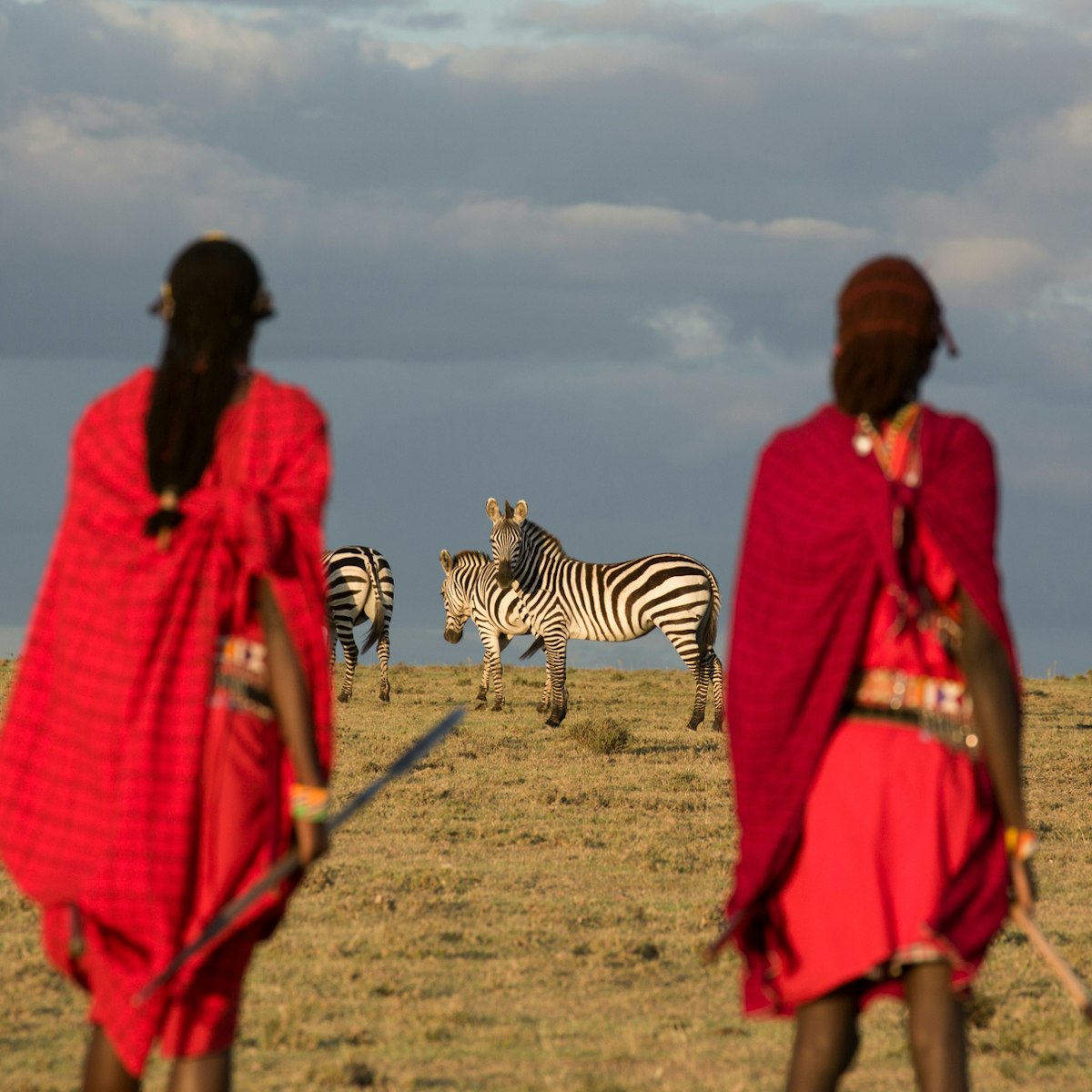
Masai Mara National Reserve
The world-renowned Masai Mara National Reserve needs little in the way of introduction. Its tawny, wildlife-stuffed savannahs are familiar to anyone who…

Narok Museum
The town’s only official attraction is the small Narok Museum and its displays on traditional and contemporary Maasai culture, as well as that of other…
Latest stories from Masai Mara
Filter by interest:
- All Interests
- Adventure Travel
- Art & Culture
- Beaches, Coasts & Islands
- Food & Drink
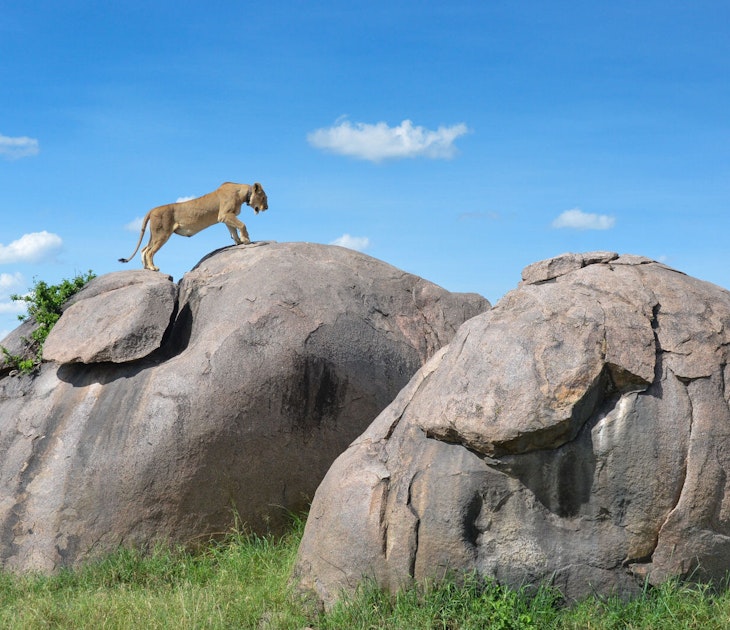
Wildlife & Nature
Jul 3, 2019 • 6 min read
From Banzai, Simba and Shenzi to Pumbaa, Timon and Zazu, the characters of The Lion King have captivated millions, both young and old, since the original…

Dec 6, 2010 • 4 min read
Purchase our award-winning guidebooks
Get to the heart of Masai Mara with one of our in-depth, award-winning guidebooks, covering maps, itineraries, and expert guidance.
Masai Mara National Reserve, Kenya: The Complete Guide
:max_bytes(150000):strip_icc():format(webp)/DSC00412-5b73daf7c9e77c0057ca2198.jpg)
brittak/Getty Images
Along with Tanzania's Serengeti National Park (with which it shares an unfenced border) the Masai Mara in Kenya is often considered to be Africa's premier safari destination. Established in 1961, it protects a multitude of animals including the Big Five ; and welcomes the herds of the annual Great Migration every year from July to November. The park's name conjures up a hundred iconic images: a cheetah and cubs scanning the plains from the top of a sunlit termite mound, perhaps, or scores of wildebeest and zebra leaping into the crocodile-infested waters of the Mara River. To make your own Masai Mara memories, plan a trip using the guide below.
Location & Geography
The Masai Mara is a relatively small reserve, covering an area of approximately 580 square miles in southwest Kenya. Its southern boundary marks the Kenya-Tanzania border and the beginning of the Serengeti; while the remaining boundaries are adjoined by private conservancies. These conservancies are owned by tribal communities and managed by eco-tourism operators, and share unfenced borders with the national reserve. The remote western section of the reserve, known as the Mara Triangle , is also managed as a non-profit conservancy run by the local Maasai. It is considered one of the best areas for game-viewing.
The Masai Mara is intersected by three major rivers: the Sand, the Talek, and the Mara. The Mara River is famous for the dramatic spectacle of thousands of wildebeest and zebra attempting to cross as part of their annual migration. The riverbanks are densely lined with trees and shrubs; otherwise, the primary habitat of the Masai Mara is open grassland studded with acacia thickets. Use this helpful map to orient yourself when choosing which part of the reserve to visit.
Incredible Wildlife
One of the reasons why the Masai Mara is so famous is that despite its small size, it's home to an astonishing concentration of animal and birdlife. Sightings of the Big Five ( lion , leopard , elephant, buffalo, and rhino) are almost guaranteed, while cheetah and smaller felines also abound. Keep an eye out for elusive predators including bat-eared foxes and spotted hyenas; and a slew of antelope ranging from topi and eland to oribi, waterbuck, and gazelle. The park's rivers are home to hippos and crocodiles, while birders can look for more than 450 recorded avian species.
Between July and November every year, more than 1.5 million animals (mostly wildebeest and zebra ) arrive in the Masai Mara as part of their annual migration from the plains of the Serengeti. Predicting exactly when and where the herds are going to show up is difficult as their movements depend on seasonal rains and grazing; but if you can observe them on the move, it's a safari experience you will never forget.
Top Things to Do
Game Drives
Traditional guided game drives in an open-sided safari vehicle are the most popular activity in the Masai Mara. Most camps and lodges within the main reserve offer two daily excursions at the best times for wildlife viewing, i.e. early morning and late afternoon. Night drives are not allowed in the Masai Mara itself, but are permitted in the neighboring conservancies.
Specialty Safaris
There are many operators who offer day trips or entire itineraries dedicated to one specific activity. These include birdwatching safaris, photographic safaris , and safaris devoted to being in the right place at the right time to watch the migration herds cross the Mara River. If you stay on a conservancy, you may also have the option to go game viewing on foot or horseback.
Hot Air Ballooning
If you have room in your budget, a dawn hot air balloon flight over the Masai Mara deserves a space at the top of your bucket list. The unique aerial perspective allows you to see for miles across the reserve's vast plains, and to observe wildlife as it passes undisturbed beneath the basket. Flights with Governors' Balloon Safaris include a Champagne breakfast.
Maasai Cultural Tour
Many safari packages and itineraries include a visit to a traditional Maasai village. Sometimes these experiences are less than authentic, but if you're lucky, you will be given a memorable insight into the lives of Kenya's best-known pastoralist tribe. They are famous for their colorful traditional dress and their incredible prowess as warriors and herdsmen.
Where to Stay
There are plenty of accommodation options located in and around the Masai Mara. Most are luxurious, and range from permanent lodges to tented and mobile camps. Before choosing which property to stay at, decide which area of the reserve you want to be based in. The central and eastern regions of the main reserve tend to see the most visitors because of their proximity to Nairobi. Lodges in these areas include Mara Simba Lodge and Keekorok Lodge .
The western Mara Triangle is more remote and harder to access, but typically offers more rewarding game viewing. There are only two options in this part of the park: Mara Serena Safari Lodge and Little Governor's Camp . For the most exclusive safari experience and a wider variety of activities, opt to stay on one of the adjacent conservancies. Our top conservancy picks include Angama Mara , andBeyond Bateleur Camp , and Elephant Pepper Camp .
Weather & When to Go
The Masai Mara National Reserve has two distinct rainy seasons: the short rains (from December to January) and the long rains (from March to May). Due to Kenya's proximity to the equator, temperatures are relatively consistent throughout the year, with average highs of around 86 degrees F and lows of around 68 degrees F. The long dry season (from June to November) is considered the best time to visit because it coincides with the Great Migration, and because animals congregate at water sources and are therefore easier to spot.
Getting There
The reserve is located approximately 170 miles west of Nairobi , and although it is possible to drive there from the capital, the state of the roads makes the six-hour journey an arduous one. During the rainy season, roads may become impassable unless you have a 4x4 vehicle and experience with driving in poor conditions. For this reason, the majority of tourists choose to fly to the Masai Mara. There are several airstrips, including those at Kichwa Tembo and Mara Serena. Flights from Nairobi take approximately 45 minutes and depart from Wilson Airport; check domestic airline Safarilink for tickets and connections to other destinations.
Visitors to the Masai Mara National Reserve must pay a daily conservation fee. This is currently $80 for adults and $45 for children under 12 years of age.
Serengeti National Park, Tanzania: The Complete Guide
Top 10 Wildlife Parks and Reserves in Kenya
The Top 5 Places to See Leopards in Africa
Kenya Travel Guide: Essential Facts and Information
How to Experience the Great Migration in Kenya and Tanzania
Top 10 Unmissable African Safari Destinations
The Best Time to Visit Masai Mara National Reserve
12 Best Things to Do in Kenya
The Best Time to Visit Tanzania
The Best Time to Visit Kenya
15 Animals to See on an African Safari
Where to Go in 2021: 10 Future Trips You Can Start Planning Now
The Best Time to Go on Safari
The Great Migration of the Wildebeest and Zebra
East Africa's 10 Best Travel Destinations
12 Best Places to Visit in December

- +254 712683442
Masai Village Visit
Meet africa’s nomadic people – the maasai and samburu, touch a moment of safari magic.

- Masai Mara National Reserve
- Amboseli National Park
- Samburu National Reserve
On our Masai village visit , you can get to know some of the planet’s most special people.
You may see them by the roadside during your safari travels in Kenya – tall, lean, and brilliantly adorned in their bright reds and blues. Their cattle are always nearby. These are the Maasai people and the closely related Samburu peoples, the oldest tribes of East Africa.
Their cattle and goats are central and sacred to their way of life, economically and spiritually as well. For they believe it is their mission to care for these animals, who in turn supply them with meat, milk, and the means from which to barter.
The men dressed in their brightly colored shukas are trained as warriors, to hunt game and keep their families and livestock safe. Both men and women are always adorned with colorful, hand-made beaded bracelets and necklaces that show off their skills and also their status.
While on safari, you can add a special cultural moment by visiting with these nomadic people in their nearby villages comprised of mud-thatched structures called bomas . Here, you can meet and learn about their lifestyle, their customs, and ceremonies.
This may well be the standout experience of your safari adventure.

Masai village tours
Arriving at the village is a study in contrasts – you’ll take in the muted greys and browns of the bomas, while the bright reds, blues, and purples worn by the villagers show off in stark relief.
Their livestock are never far off – you’ll see them in the small corrals made of sharpened poles and branches to fend off predators.
While here you may have an opportunity to visit inside one of the bomas, usually constructed by the women from small poles and smaller branches, then covered with a cement of mud, grass, dung, urine, and ash.
Although you’ll have to stoop to fit inside the 1.5M (less than 5 feet) high structure, the family eats, sleeps, and carries on all activities in this modest home.
It’s the men’s responsibility to build the corrals and the protective fencing around the village to ward off the big cats and any other predators that are attracted to the livestock.

Music and Dance
You may get to experience the villagers singing and dancing… and you might even be able to join in! The Maasai are known for their rhythmic call-and-response singing. Perhaps their most widely known dance is the adumu or “jumping dance”.

Experience the culture
As mentioned, the women and men adorn themselves with colorful beaded necklaces, bracelets, and amulets. Fashioned from wood, bone, metal, or glass, the brightly-colored beads are more than just jewelry. There is symbolism to each color and design, representing status as well as beauty, strength, health, and purity.
While at the village you’ll have opportunities to purchase a great variety of beaded jewelry as a memento of your visit. For the Maasai, their jewelry is an important source of income.
“The Jumping Dance”
If you’ve ever seen video of the Maasai in ceremony it was most likely images of the men jumping and rising high into the air. This joyful jumping dance is called the Adamu and is a traditional way for the men to show off their strength. And perhaps attract a wife.
Forming a circle with one warrior in the center, the dance is powered by the villagers’ call-and-response singing. And it’s not uncommon for guests such as yourself to be invited into the circle to join the fun. You’ll be jumping next to a tall Maasai… but don’t expect to jump higher than him!

Where can I see the Maasai people?
On your safari, there will be plenty of chances to visit these indigenous people as their villages are located in or near several national parks. One famous park, the Masai Mara is named in their honor. The Mara is famous for its big cats and great herds of wildebeests, but while here don’t miss an opportunity to pause and meet these fascinating local people.
Amboseli Park is famous for its great numbers of free-ranging elephants marching before the snow-capped majesty of Mt. Kilimanjaro. But you can also visit a Maasai village here to bring a cultural moment to your safari adventure.
Should you be journeying north to Samburu Park , be sure to visit the local Samburu village. Though not as well known as the Maasai, the Samburu are considered their traditional cousins. Their culture, village, and way of life are very similar as they too are pastoralists whose lives center around the raising of cattle.
Embrace the African culture
When you book your tour to the Masai Mara, Amboseli, or Samburu Park, just let us know if you would enjoy a side adventure to visit a local village. The cost is just $20 per person and payable to the village chief.
While on safari you can also let your guide know you’d like to make a detour to visit a local village and he’ll be happy to make all the arrangements.
And of course, if you have any other requests for your African safari please let us know. We’re always here to make your Kenya vacation unforgettable.

MASAI VILLAGE CULTURAL VISIT PRICES
US$ 20 Per Person
(Arrange with your safari driver/ guide. Payable to Masai village chief)
Our clients
Driving technology for leading brands, our accreditations and booking security.
Africa Kenya Safaris Ltd is licensed under the Kenya Tourism Regulatory Authority ( TRA ) . It is Bonded member No. AS/720 of the Kenya Association of Tour Operators ( KATO ) , Ecotourism Kenya , East African Wildlife Society, and the African Travel and Tourism Association ( ATTA )
Game Drives
Hot air balloon.
- Walking Adventure
- Night Game Drive
Cultural Visit
Bird watching.
- Luxury Camps & Lodges
- Mid-Range Camps & Lodges
- Budget Camps
- Eco-friendly Camps
- Private Villas
- Self-catering Accomodation
- Nairobi to Maasai Mara via Road
- Nairobi to Maasai Mara Flight
- Mara Conservation
Maasai Mara National Reserve
The Maasai Mara National Reserve is a breathtaking wildlife sanctuary located in the Narok County of Kenya. Named after the Maasai people, the area’s indigenous inhabitants, and the Mara River which divides it, this reserve is globally renowned for its exceptional wildlife population, picturesque landscapes, and unique cultural experiences. Spanning approximately 1,510 square kilometers, the Maasai Mara offers visitors an unforgettable opportunity to witness the beauty of nature at its finest.
Established in 1961, the Maasai Mara National Reserve forms a part of the greater Mara ecosystem, which also includes the Serengeti National Park in Tanzania. The reserve is situated at an altitude of 1,500 to 2,170 meters above sea level, providing a variety of habitats to support its diverse wildlife population. The area experiences two rainy seasons: the long rains from March to May and the short rains from November to December.
The Maasai Mara is home to an abundance of wildlife, including the famous “Big Five” – African elephants, lions, leopards, buffalo, and rhinoceros. Additionally, it hosts over 450 bird species, including vultures, marabou storks, and ostriches. The reserve is globally renowned for the annual Great Migration, during which over 1.5 million wildebeest, zebras, and gazelles traverse the Mara River in search of greener pastures between July and October.
The Maasai Mara National Reserve is a must-visit destination for nature enthusiasts and wildlife lovers. With its unparalleled natural beauty, abundant wildlife, and rich cultural experiences, a visit to the Maasai Mara is sure to be a once-in-a-lifetime adventure.
Activities to Do in The Mara
Walking safari, horseback safari, wildlife photography.

MAASAI MARA FACTS
The Maasai Mara National Reserve is one of the world’s most famous and important wildlife conservation and wilderness areas. Here are some facts about it:
Great Migration
People & culture, why visit the maasai mara, extraordinary wildlife, luxury safari lodges and camps, breathtaking landscapes, the great migration, get in touch, +254113420342, [email protected], maasai mara national reserve, narok county, kenya., monday - sun: 06:00- 18.00, send us a message we will get back to you..
Name* Mail* Phone number* Your message

The Maasai Tribe: What a Visit is Really Like
Written By: The Planet D
Updated On: December 20, 2021
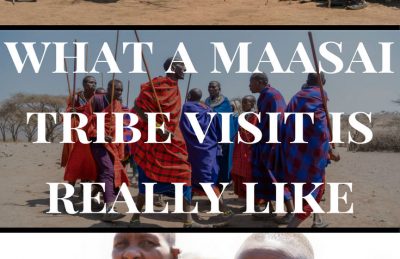
A visit to a Maasai tribe is a popular stop on nearly every safari you’ll take through Tanzania and Kenya. After all, it is the “must-see” tribe to see when going to the Serengeti or Masai Mara.
Table of Contents
What a Maasai Tribe Visit is Really Like
This is the tribe that is in all the brochures and magazines. While we highly recommend stopping at a Maasai village, there are a few things you should know before you go. What a Maasai Tribe Village Visit is Really Like.
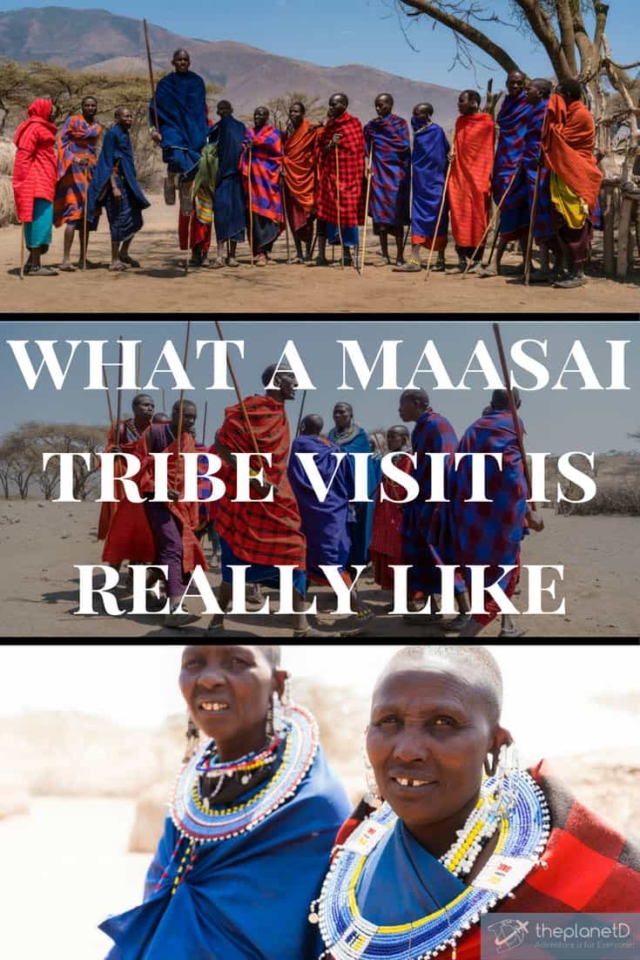
You’ve all seen those amazing photos of Maasai warriors jumping high in the air with the arid African savanna as their backdrop. The scene makes for stunning photographic opportunities and it is certainly one of the ways you’ll be able to capture the moment on your own.
But the Maasai tribes of Tanzania are organized and well schooled when it comes to making money off of tourists.
They will bleed you of your last Loonie (dollar) in your pocket if you let them, so instead, be prepared, know what to expect and you’ll come away from your Maasai tribe visit with a smile on your face and a super cultural experience to remember.
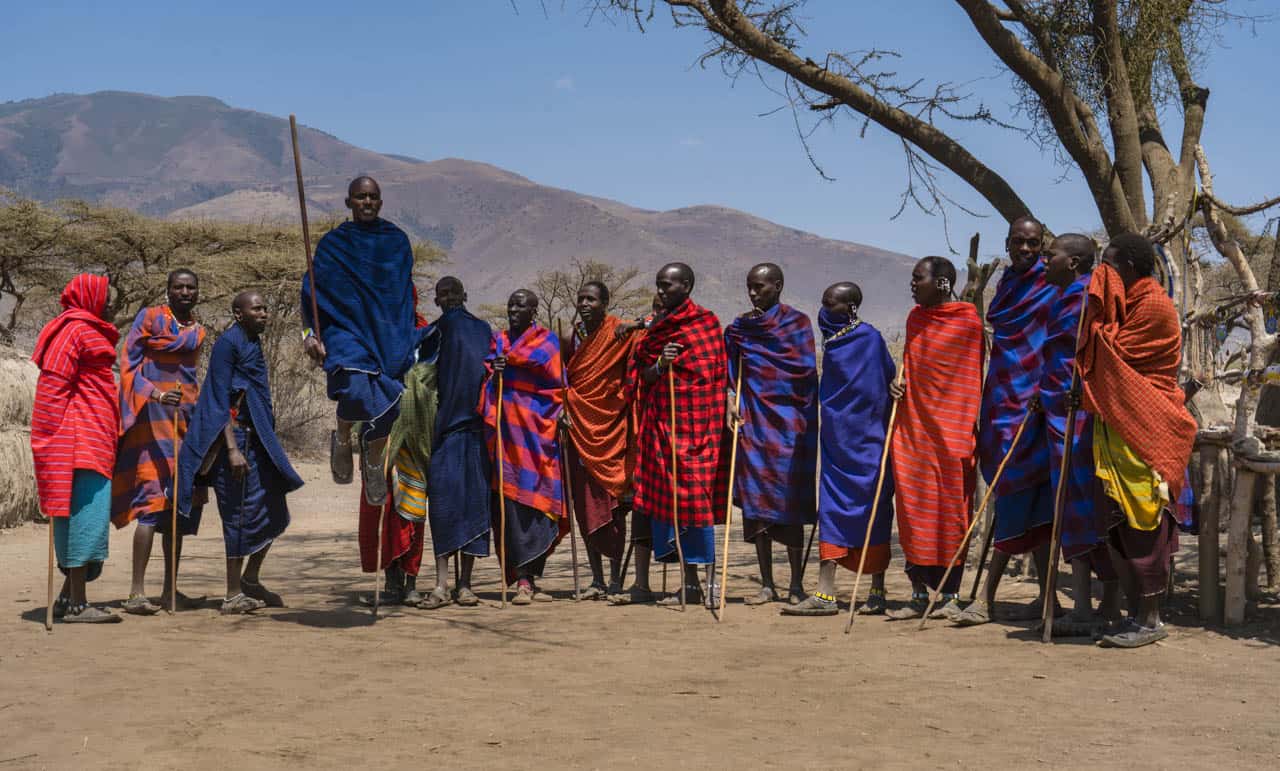
We were a group of 13 people on a Go Ahead Tours safari en route to the Serengeti National Park in the Ngorongoro reserve. Maasai Villages dotted the road along the way and different tour operators make stops at different camps.
The Greeting
We were greeted with smiling faces and lively music as we pulled into the gravel parking lot of the village. Maasai men dressed the males of our group in traditional sarongs as the women put necklaces and wraps around the ladies. Feeling the part, we followed them into camp as they chanted and sang.
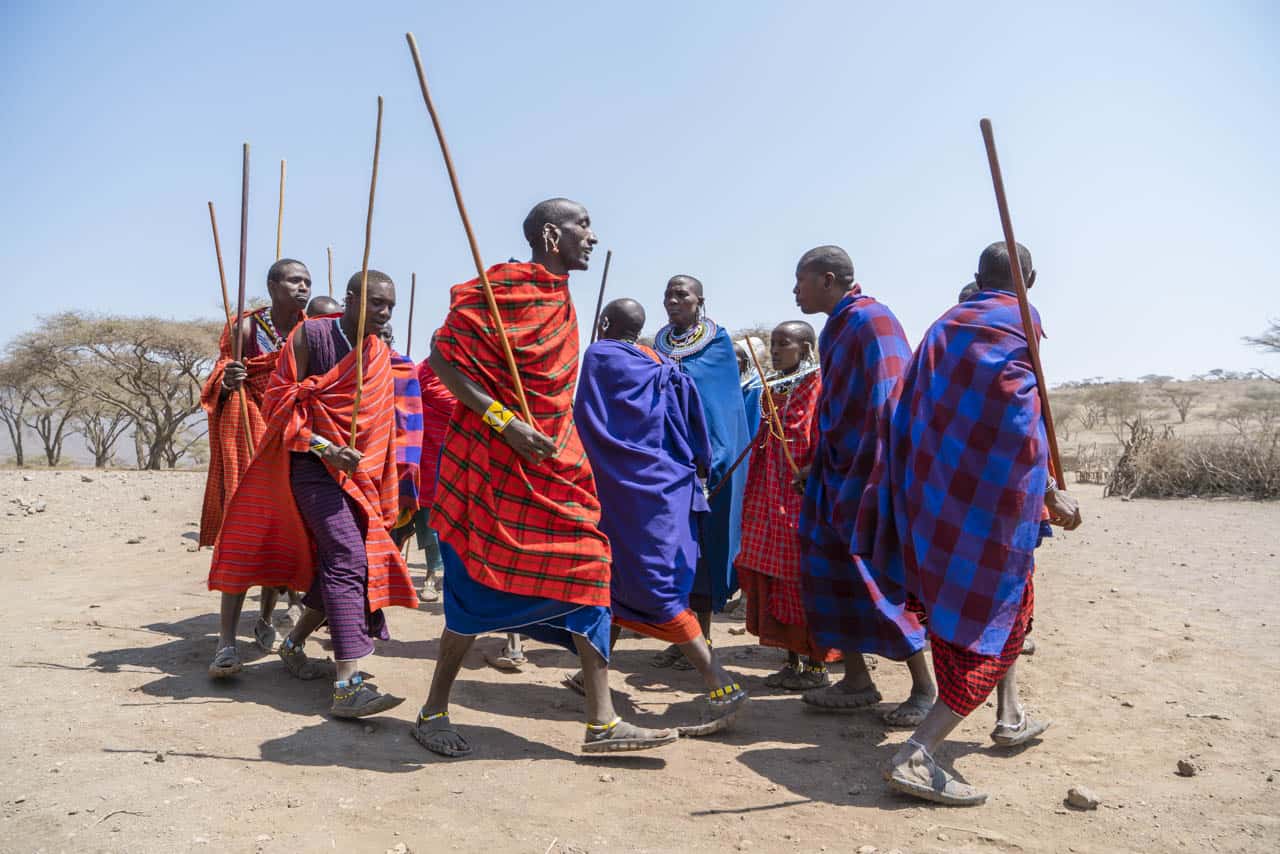
The circular camp consists of mud huts surrounded by a thorn tree fence to keep the wildlife at bay. Livestock is traditionally kept inside the camp, but while tourists visit, the cows are out grazing in the surrounding fields. Inside, we learned of the villager’s way of life starting off with a lively performance of men jumping for joy.
What does all that jumping mean?
The dance is a rite of passage for male warriors in the Maasai Tribe as their jumping skills are used to attract a mate. The higher they jump, the more appealing they are to the ladies. Speaking of the ladies, they all watch the scene singing and chanting to a steady beat as the warriors jump higher.
I didn’t know it at the time that this was a mating dance, and I can’t help but wonder now what all the laughing among the girls meant. Was each young man jumping to impress them as much as they were trying to impress the tourists?
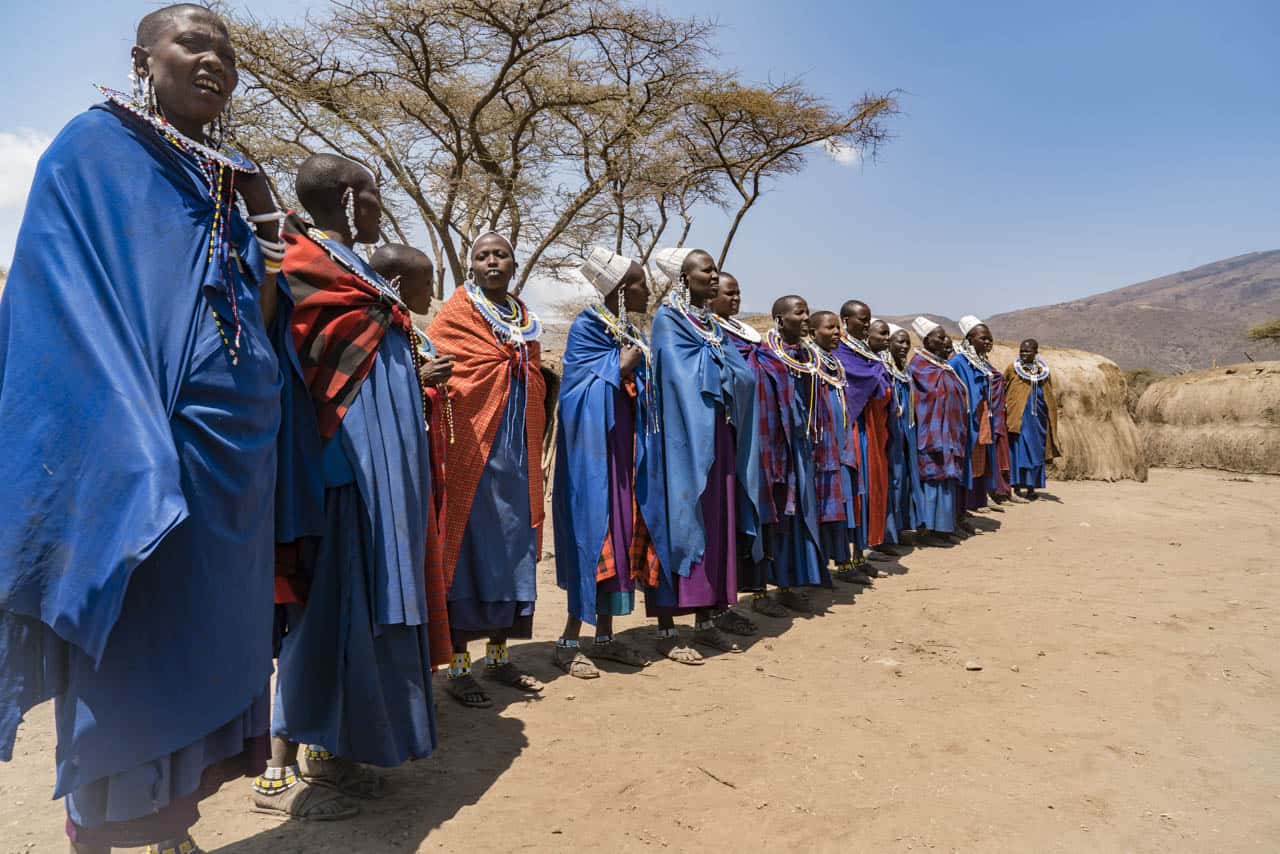
I got the feeling that they didn’t really care if we were there or not. They would have jumped for each other to impress the girls regardless.
The importance of making fire in the Maasai Tribe
After all that energy and testosterone were expelled, the men went on to show us how they make fire. We had seen this before in Kenya and the Maasai men take pride in their fire-making skills.
They are often sent off on their own to learn to hunt, survive and thrive before coming back to the village. Making fire is a valuable skill and they do it only with sticks and dried leaves.
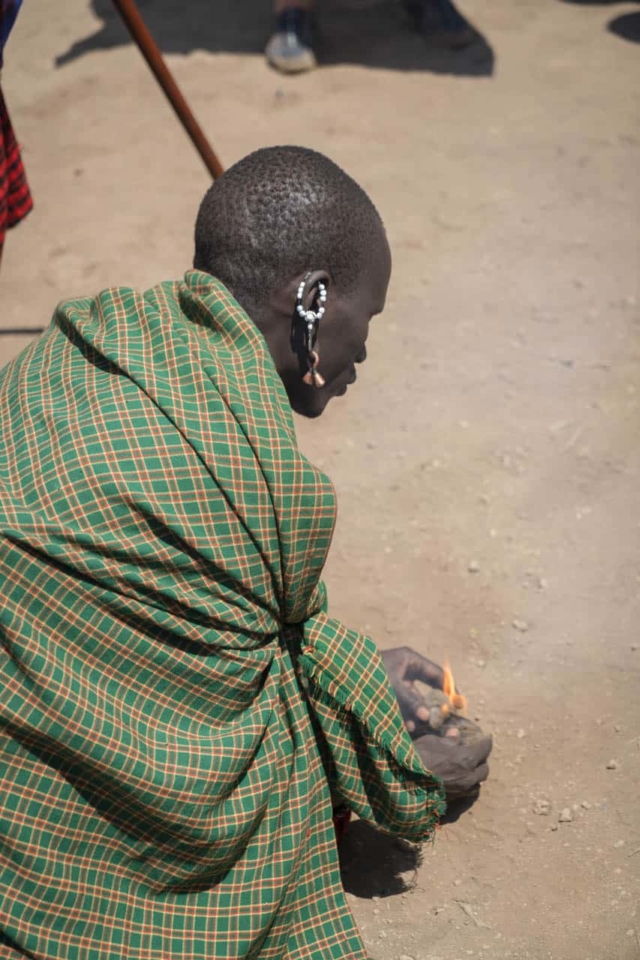
Within minutes the fire is built and our warrior looks on showing the fire with great admiration of his skill. We recommend taking part in as many of these demonstrations as possible.
It’s fun to join the warriors in jumping and the women in singing and dancing. The more you participate the more you get out of it. After the entertainment, everyone was broken off into smaller groups to enter the Maasai houses.
Where the Maaasai Live
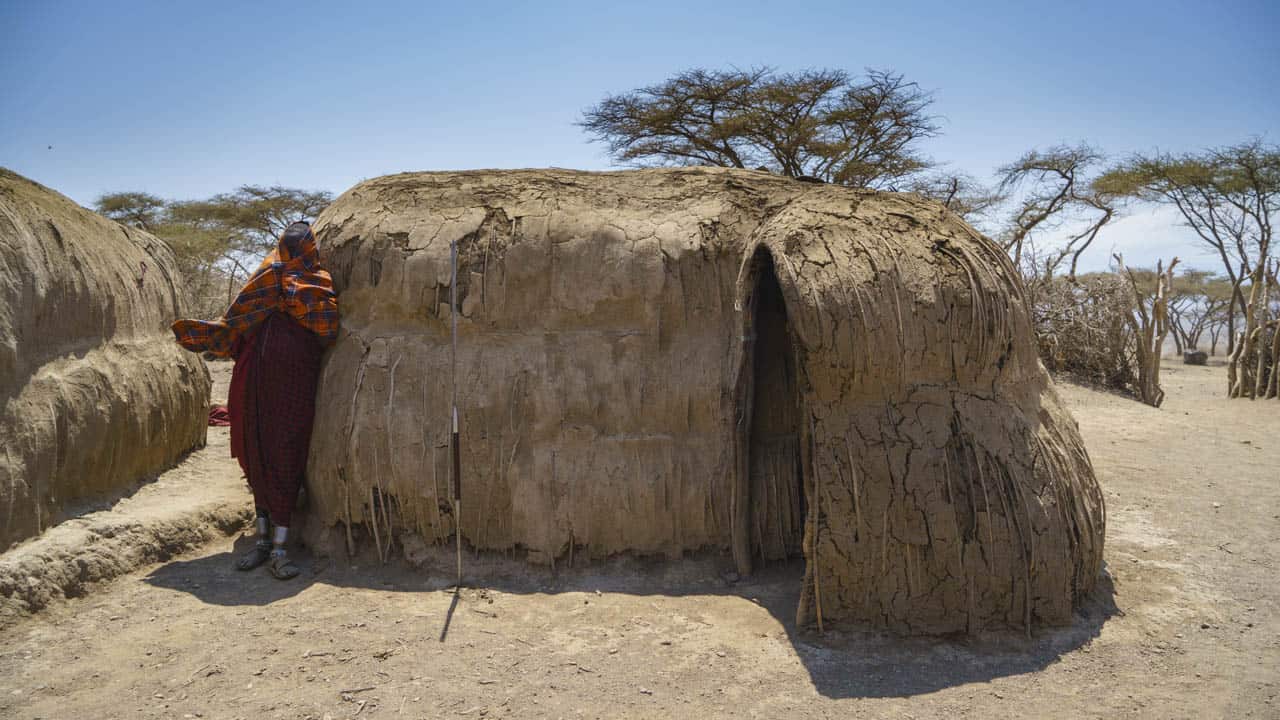
The houses are small and dark. They are made of mud and we are told that they last up to five years before they tear them down and start again. It’s tiny quarters with two separate benches for sitting during the day and sleeping at night.
Mom and dad sleep on one side and all the young kids sleep on the other. Once they reach the age of 5 or so, they move to another hut. I can’t imagine what it is like to live in such cramped quarters.
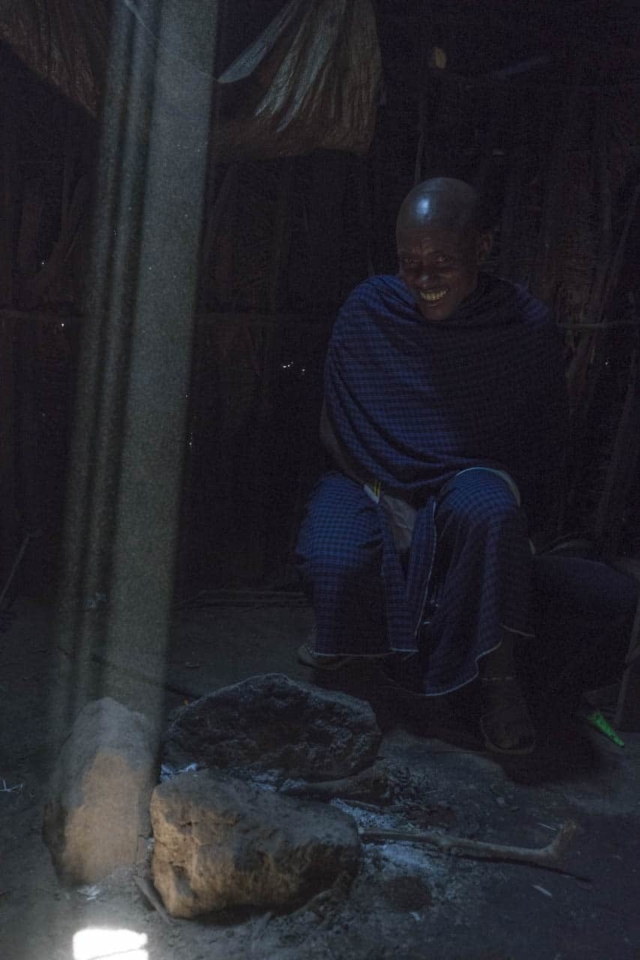
The other half of the hut is the kitchen where food is prepared. There is a hole in the roof to let the smoke out. That is really all there is to tell. The huts are no bigger than a large family tent and they look far less comfortable.
We heard from fellow travelers on our tour that the Masai live on a diet of milk, meat, and blood. But our Maasai guide told us that they eat oatmeal for breakfast. They also forage for vegetables and eat maize.
It is after the show and tell and performances that tourist need to be prepared.
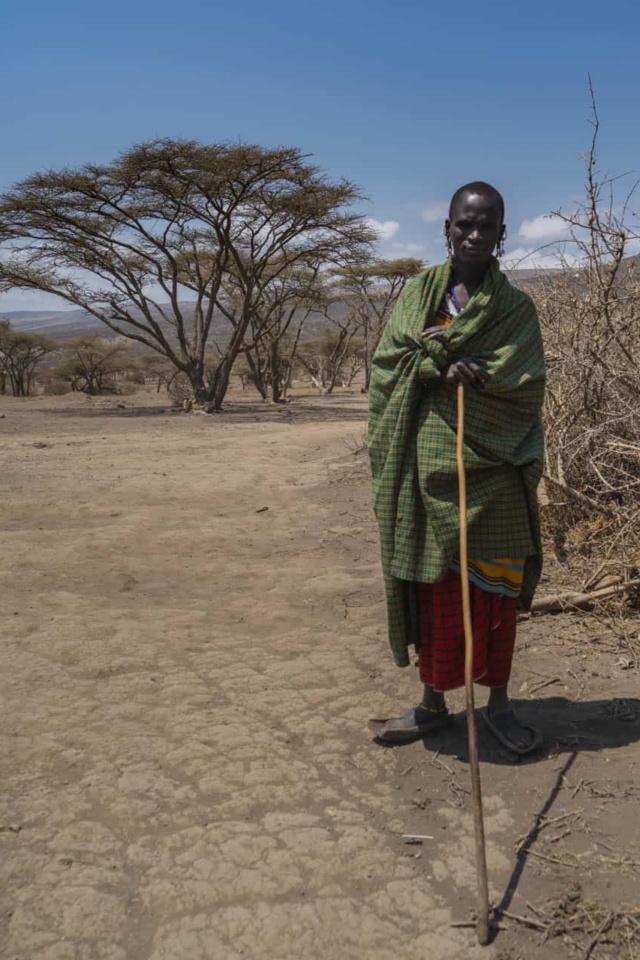
Once you finish up in the hut, you are led out to the center of the village to browse jewelry and traditional craft.
Dave and I always support the local economy and the villages we visit. We realize that this is their main source of income and have no problem buying a souvenir or two within reason.
We chose a few bracelets and a necklace and when asking about prices, we kept getting the same answer. “Once you are finished we’ll talk.”
Let the bartering begin
We finished up our shopping and our Maasai guide took us aside away from the rest of the group to let the bartering begin. He didn’t want any of us overhearing what each other paid for things and made sure to start the prices high.
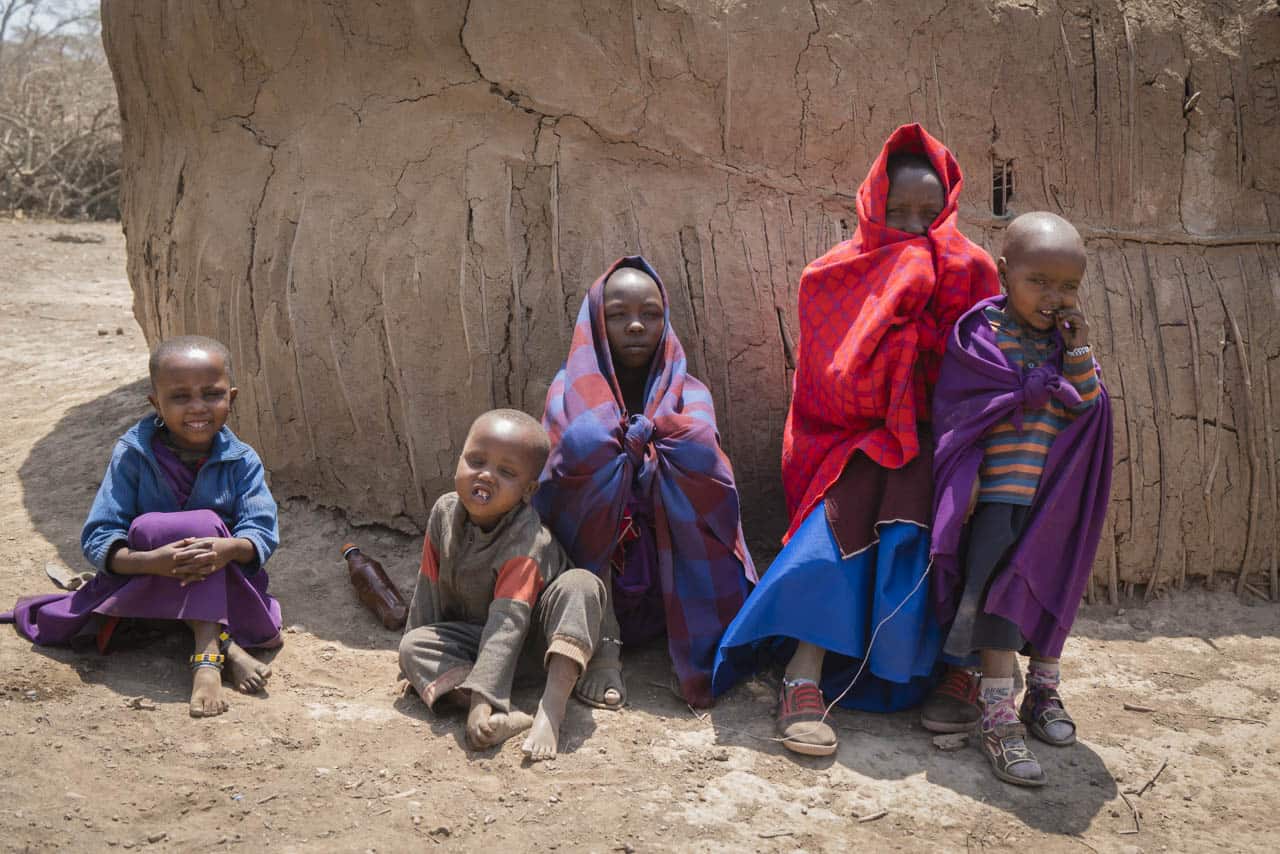
For two bracelets and a necklace, ours started at $75 USD. (about $100 Canadian)
That was way beyond what we were prepared to pay for jewelry that we’d never wear. Maasai jewelry isn’t my favorite choice of bracelet or necklace, but I don’t mind giving some cash to buy them and have them in my collection.
At 75 bucks we were a little taken aback, so instead of bartering, we just handed him back our choices and said, “You are way beyond what we will pay and we don’t want to insult you so I think we’ll just give it back.”
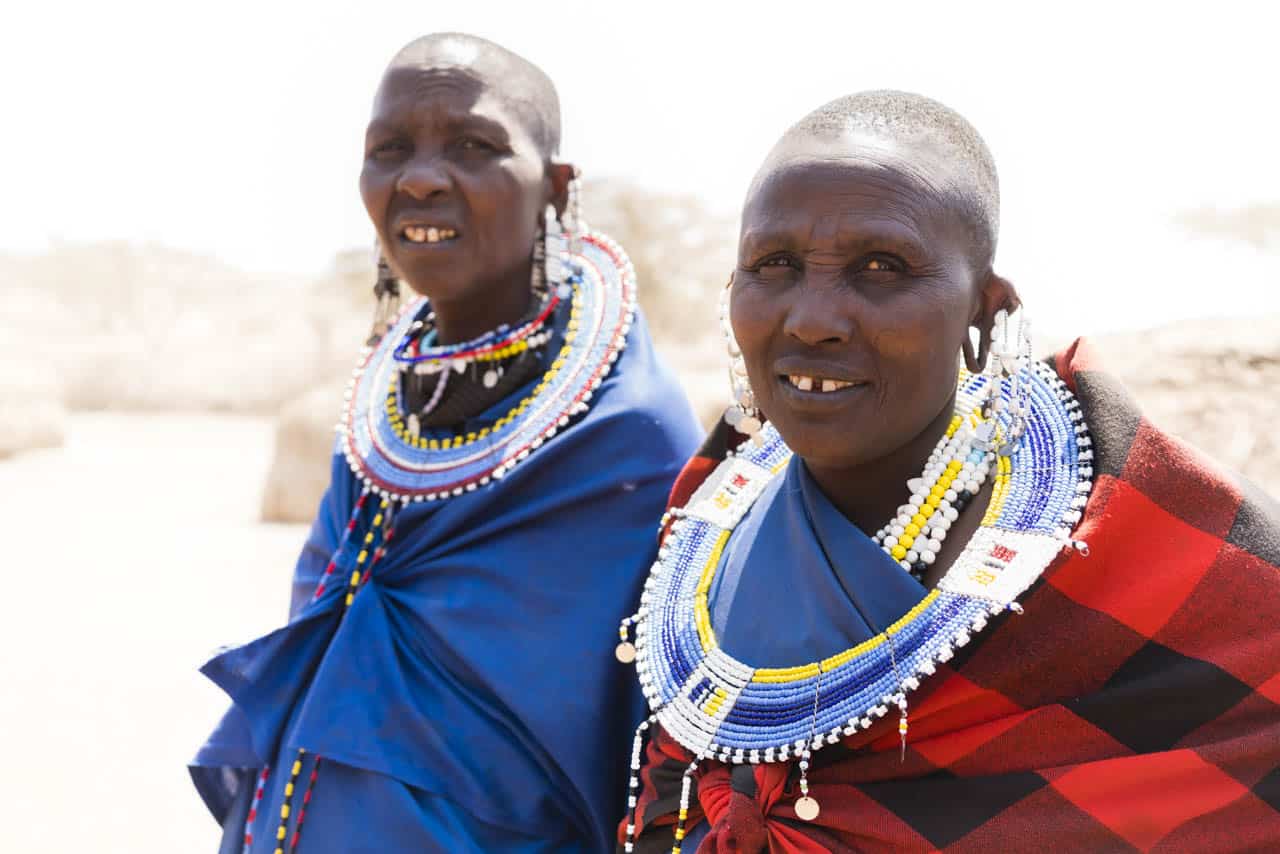
We started to walk away to the next stop on our tour, but he was quick to follow.
“How much do you give?” He asked. We replied, “It’s okay you keep it.” Eventually, he came down to $20 for two bracelets. That was still more than we wanted to pay, but we settled on $15 and a Canadian Toonie.
Note: I will pay $20 for a bracelet. I actually paid $25 for a handmade bracelet at Shanga in Arusha, but it was beautiful, hand crafted and made by a disabled person. This bracelet was exactly like every other Maasai piece out there. It fell apart within days of buying and heck, I can never be sure if it is made by hand at the village or bought in China at this point. But as I said, I am happy to contribute to the economy.
Visiting the Maasai School
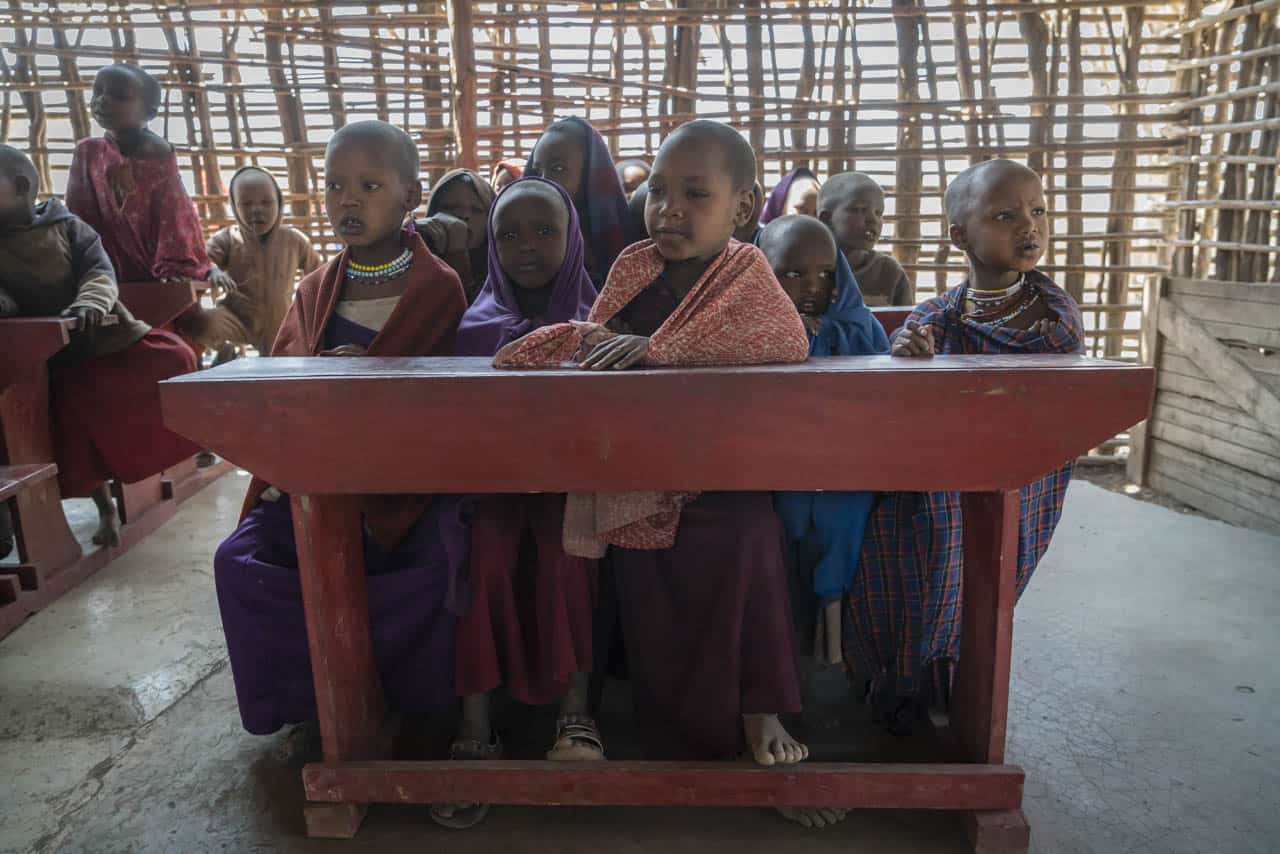
A word of caution, don’t let the Maasai take you for all your cash on hand. Because the next stop is the children’s school and you can donate to the fund to help in their education.
A lot of people ended up giving all their cash to the sneaky Maasai merchant and didn’t have anything to donate to the school. I don’t think it is the end of the world since all your money goes to the village regardless, but it does feel nice to be able to put a couple of bucks into the can.
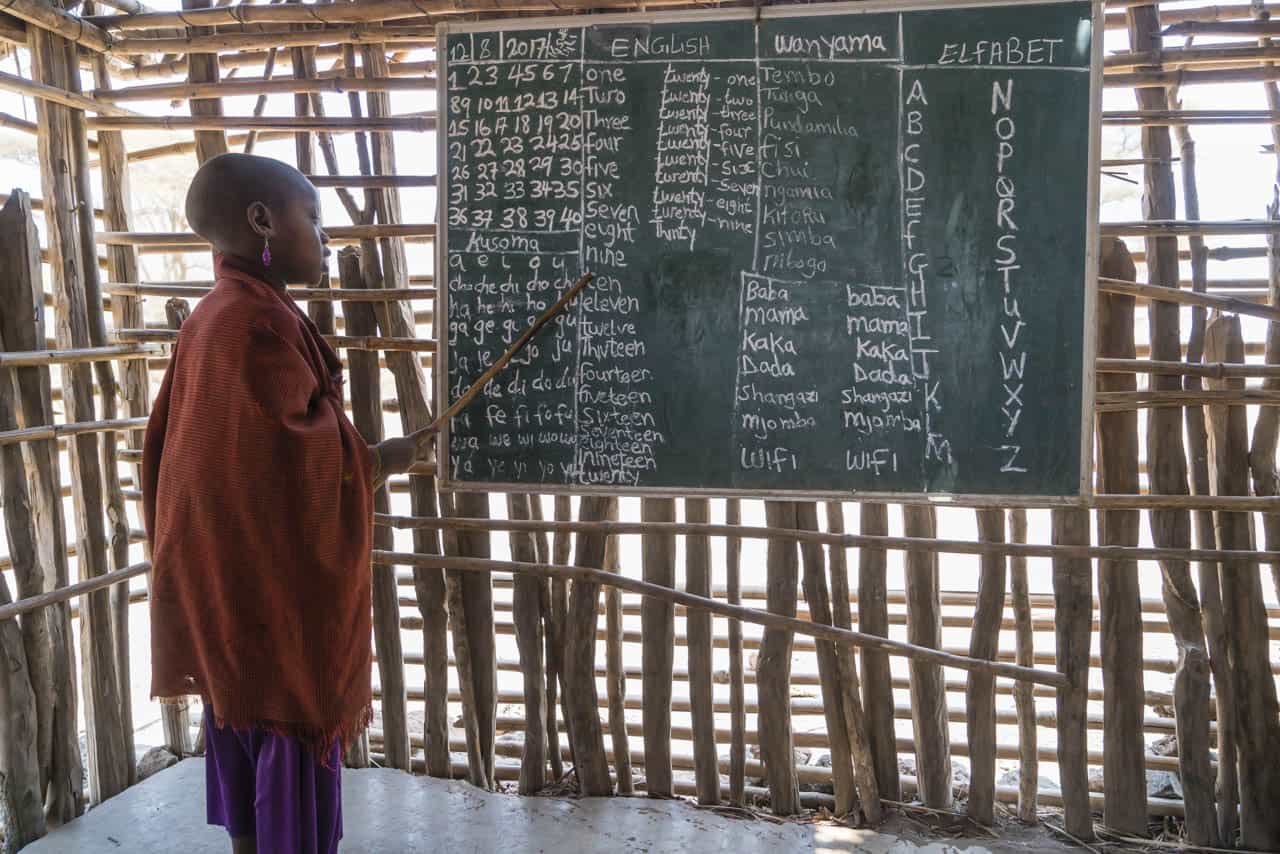
The school visit was cute if not a bit staged. Children got up like robots to show us their knowledge of the English alphabet and number system. Our group stuck around for a little while to take photographs and noticed that we were still inside when the next wave of tourists came in.
We noticed because the kids were back up repeating the show they had just put on for us a few minutes ago. It was a little disheartening and I had to wonder whether the kids were being used to make money all day long, or if they just put up with us for a few minutes a day before going on with their studies. Either way, everyone looked healthy and seemed very happy.
Leaving the Maasai Village
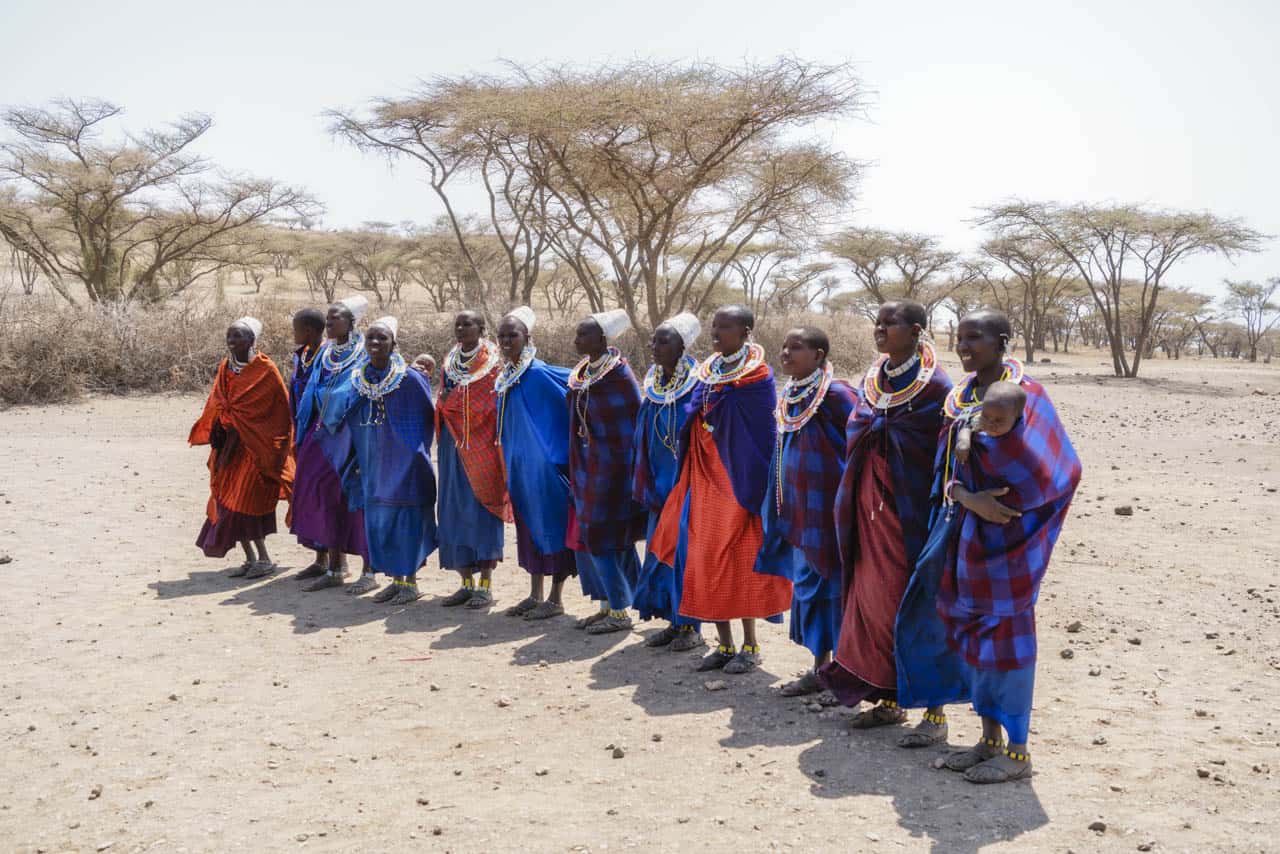
On our way back to the trucks, our “friendly neighborhood Maasai merchant” approached us with the traditional necklace we turned away in his hand. He pulled us aside from the rest of the group and asked if we’d be willing to pay $20. And we said sure.
He tried to trade out the necklace for a smaller more battered one when we went to pay, but we held fast. “ Ah, that’s not the one I wanted. ” We smiled. He smiled and pulled the original out to give to us. Our transaction was complete. We went away spending $35 on a couple of Masai pieces and felt good about our purchases.
We felt it was all a fair price and we know (from all our years of travel) that they never would have sold it to us had it not been)
But don’t feel that you have to buy something when you do a Maasai village visit. The tour companies pay a fee to enter and the Masai are already making money off of your visit. The crafts are extra. While you don’t have to buy anything if you don’t want to, it is nice to get a keepsake for your memories and to help the local villages perhaps send a child to school.
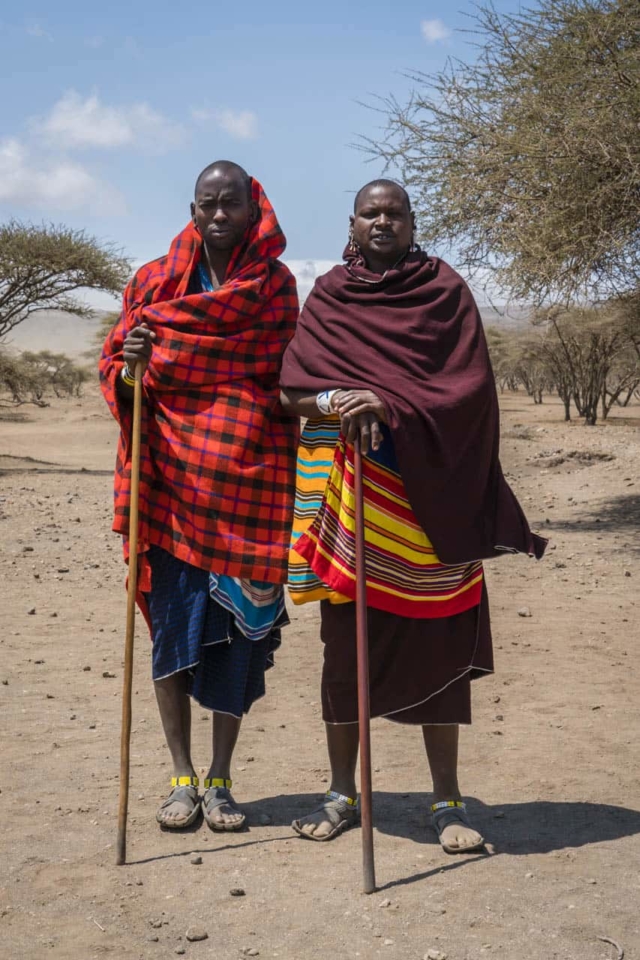
Some people on our tour came away feeling a bit dejected about the money they spent.
They felt compelled to pay the first price quoted and once they were back in the truck they felt a little “taken.” I responded to them saying “As long as you got something to bring you memories that’s all that matters. If you felt that the price was good at the time, then that is fine.
Dave and I never told anyone in our group what we paid.
We tend to be a little cheap after all our years of bartering around the world. We’ve worked on loosening our wallets over the years, but we still can’t help but exchange back and forth when we know their prices are way too high.
I do know that some people were relieved of close to a couple of hundred bucks. That’s an awfully good payday for the village if I do say so myself.
Masai Mara Experience
Hot air balloon over the masai mara, on safari in tanzania – the ultimate wildlife experience, the maasai people kenya – a special stop at selenkay.
Travel Planning Resources
Looking to book your next trip? Why not use these resources that are tried and tested by yours truly.
Flights: Start planning your trip by finding the best flight deals on Skyscanner
Book your Hotel: Find the best prices on hotels with these two providers. If you are located in Europe use Booking.com and if you are anywhere else use TripAdvisor
Find Apartment Rentals: You will find the cheapest prices on apartment rentals with VRBO .
Travel Insurance: Don't leave home without it. Here is what we recommend:
- Allianz - Occasional Travelers.
- Medjet - Global air medical transport and travel security.
Need more help planning your trip? Make sure to check out our Resources Page where we highlight all the great companies that we trust when we are traveling.
You May Also Like
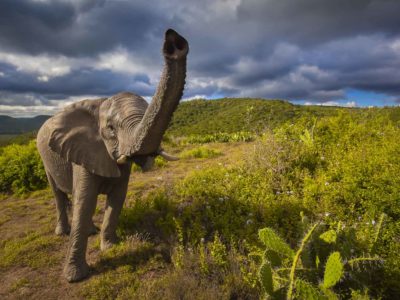
African Animals – Incredible moments on Safari
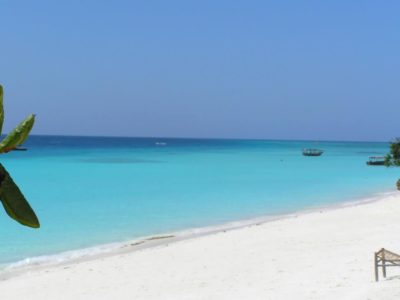
Discover The Best Beaches in Zanzibar
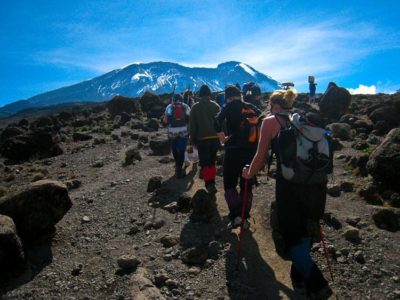
Complete Guide to Climbing Mount Kilimanjaro – How Hard is It?
About The Planet D
Dave Bouskill and Debra Corbeil are the owners and founders of The Planet D. After traveling to 115 countries, on all 7 continents over the past 13 years they have become one of the foremost experts in travel. Being recognized as top travel bloggers and influencers by the likes of Forbes Magazine , the Society of American Travel Writers and USA Today has allowed them to become leaders in their field.
Join thousands of others who get our monthly updates!
Leave a comment cancel reply.
Save my name, email, and website in this browser for the next time I comment.
6 thoughts on “The Maasai Tribe: What a Visit is Really Like”
I’m deciding to visit a village in August and the bartering and selling shouldn’t surprise anyone. Look where they live, what they lack. And your visits are seasonal for them. So like any tourist place, including Turkey, Italy, etc, the locals will try to get what they can. I don’t think you can go in naive. Your review is very honest, which is great. I visited China last year and visited a school and the kids also recited lessons. It’s the same in the US! Nothing wrong with any of this. I consider it a privilege to visit the Maasai and am willing to make a donation to their way of life. As for the cell phones, they are super cheap and the cellular plans are amazingly cheap in developing countries. Almost anyone can own them now so don’t think it’s a sign of hidden wealth! I love visiting people in other countries and look forward to my Maasai visit!
The pictures are really colorful and have a certain attraction which made me go through all of them. The intense details and the reality of every picture is very descriptive and says more than the blog. h
I’ve always wanted to visit the Masai, but this article has give me some more food for thought with regards to the money grab. I can’t stand it when I feel continuously on guard. I will probably still get there one day, but at least now I will be better prepared. Thanks for an honest review.
We also did a tour in Tanzania that was just like this. I felt it was staged also and haven’t had the heart to write about it yet. On our tour of a house I spied a cell phone on one of the beds and wondered how authentic this village was. I later heard the stops on major roads are for tourists and a bit of a show while the authentic Maasai were in more remote areas. I do wear my bracelet all the time though, it is a great memory of climbing Kilimanjaro:)
When I read about your visit to the village as if I went back there. We have the same experience as you. First dancing, then we wanted to buy wooden figurines rhinoceros, but given the prices, we didn’t finally buy it. (Later we bought a nicer directly from a carver in Zanzibar for much less). We also visited the school, but we gave to children the inflatable balloons, which made children much happier 🙂 Anyway, we are happy that we see the village, but at the end we felt like walking wallet :/ Here are our pictures: http://etabroad.com/en/visit-maasai-village-could-you-live-like-them/ we were in a bit smaller village.
Thanks for sharing you experience. It is true. Dave and I mentioned to each other that we think the Maasai harnessed tourism early and have since seen it as a cash grab. While we understand it is the way they earn a living, they need to work on being less pushy and more sharing about their culture.
Get the latest updates about Bushtops, our offers, migration season, and more straight to your inbox.
The Bushtops website uses cookies. If that’s okay with you, keep on browsing, or learn more about our Privacy Policy
Masai Village Visit
Meet our Local Partners
We highly recommend a visit to a Masai manyatta (village), to gain a rare insight into one of Africa best-known traditional cultures. Our relationship with local tribal elders has built trust and an agreement to allow us privileged access to authentic living history, perpetuated in the villages which border and share our private conservancy.
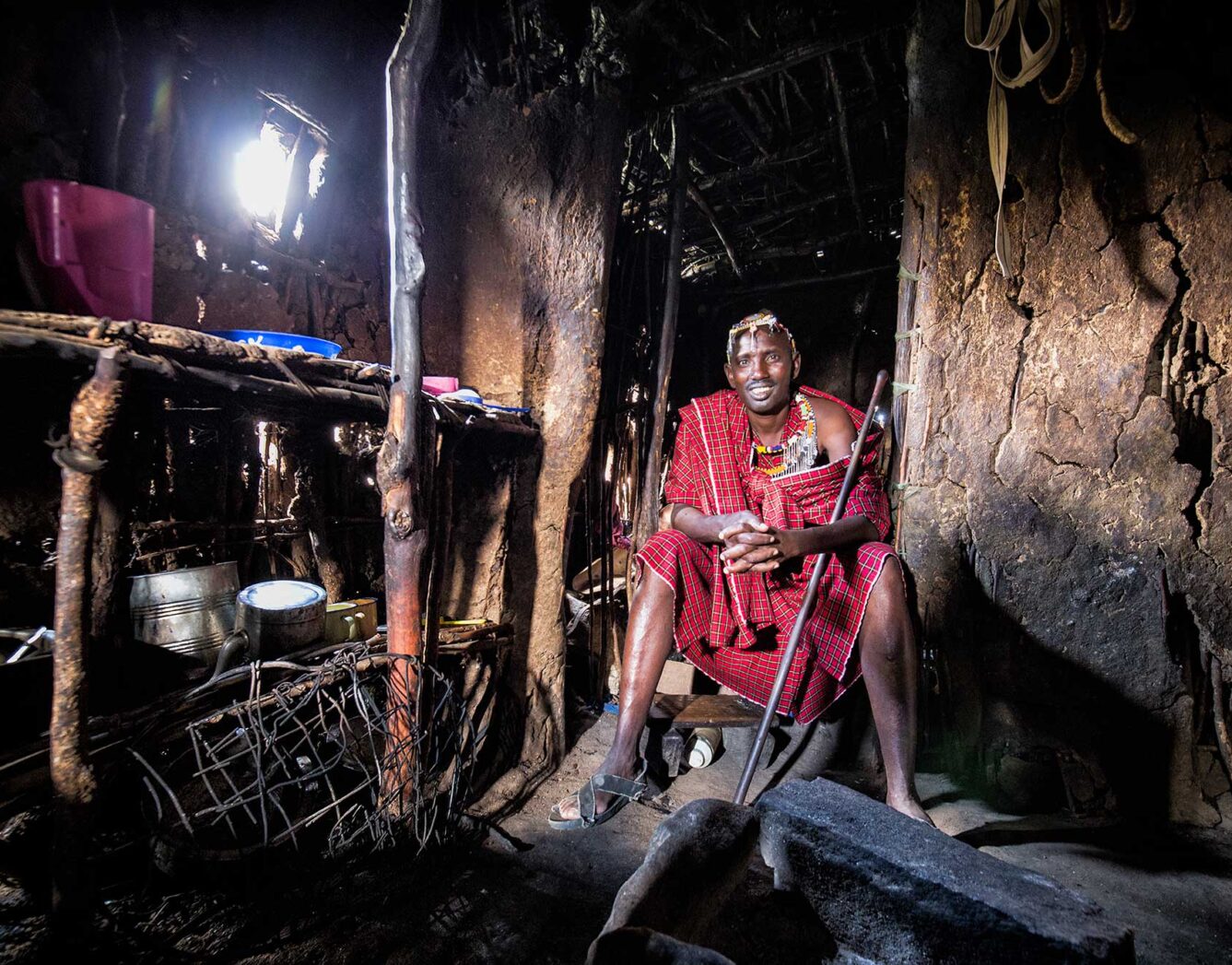
A village visit opens the door on a unique way of life and set of traditions. Your ranger will drive you to the village where Masai warriors and women ceremoniously receive you as a respected visitor. Having been introduced, a Masai host will give you a tour of the manyatta, explaining the lifestyle and what lies inside one of the huts. Your ranger and spotter remain with you throughout the experience to help with communications. As a standalone visit, or in combination with a visit to the Kakiya cave, this is a wonderful way to reconnect with a living culture – one that links all of us to our shared African past.
- Village is 15-minute drive from our camp
- Each visit lasts approximately two hours
- Opportunity to browse Masai artefacts (with no pressure to buy)
- 25 USD per person charge goes directly to the community
- Option to then visit Kakiya cave
Proudly Featured In

- How to Tie a Tie
- Best Coffee Beans
- How to Shape a Beard
- Best Sweaters for Men
- Most Expensive Cognac
- Monos vs Away Luggage
- Best Luxury Hotel Chains
- Fastest Cars in the World
- Ernest Hemingway Books
- What Does CBD Feel Like?
- Canada Goose Alternatives
- Fastest Motorcycles in the World
A Visit to a Maasai Village in Africa (Photos)
As you wind down through the hills from Sanctuary Olonana towards the Maasai Mara National Reserve in Africa, you will catch a glimpse of all kinds of wildlife . Zebra, giraffes, impala, and baboons, sure, but you’ll also see cattle. And accompanying the cattle are men wrapped in bright red blankets and holding staffs. These are the Maasai.
The Maasai are a semi-nomadic, indigenous African community that spans from Northern Tanzania to Kenya. To them, cattle is everything. A gift from the god, Enkai, cattle is used in everything from their diet, which is made up of milk, curdled milk, and blood (they rarely eat beef), to their housing ( enkaji ), which is a mix of grass, mud, and dung. A man’s worthiness for marriage — the Maasai are polygamous — is determined largely by the number of cattle that he owns.
At no time do the Maasai leave the cattle unattended in the pasture. Men always wear red because they believe the bright color will frighten off the lions that prey on animals in the area. From the time they can walk, the Maasai men monitor their herd. At puberty, boys undergo a series of tests to become Maasai warriors.
- Yellowstone vs Yosemite: Which national park should you visit?
- The new rules to know if you visit one of Tulum’s most popular attractions
- When’s the best time to visit Costa Rica? It depends on why you’re traveling
Because of the Maasai tribe’s proximity to some of Africa’s most visited game parks (Maasai Mara, Serengeti , and Tarangire ), they are also one of the most well-known African natives. Unlike many other, far more private indigenous groups, the Maasai are also known to welcome visitors to their villages to learn about their customs and way of life. Travel companies like Abercrombie and Kent and Sanctuary Retreats work with the Maasai to invite travelers to participate in ritual dances and shop at the markets where the tribe’s women sell locally made beaded jewelry and wood carvings made by the men while tending cattle.
When visiting the Maasai, respect is the name of the game. Let them take the lead when it comes to interactions and you’ll be sure to learn and enjoy all the time you spend with these happy and resourceful people.
Maasai villages, called bomas, are circular in structure with a handful mud homes on the perimeter. The center is kept empty and livestock is brought in at night in order to protect the cattle from lions and thieves. The fence itself is constructed of thorned acacia branches and each gate into the village represents a family.
To the Maasai, nothing is more important than cattle. Most affairs and conflicts are resolved using cattle as trade and a man’s number of wives is determined by the number of cattle that he owns. Often 10 cattle equal one wife.
The Massai homeland between Kenya and Tanzania.
Maasai warriors participate in an adumu , or as it is known by western visitors, the Maasai jumping dance. The men get into a circle and begin a call-and-answer chant. Each male enters the circle where he jumps as high as he can. The higher he can jump, the more attractive that he is to the opposite sex.
Often, tourists visiting Maasai villages are encouraged to participate in the adumu .
Maasai begin looking after livestock when they are toddlers.
When a Maasai boy reaches the age of five, his lower front two teeth are removed. If the child gets lockjaw, an antidote can be administered through the gap.
A curious Maasai boy peaks around a corner.
When guests visit a Maasai village, among other activities, the Maasai warriors demonstrate how they make fire.
Maasai elders are responsible for all tribal politics and ceremonies.
Massai children sit with their grandmother.
Maasai homes are loaf-shaped, typically made up of two rooms and built by the women of the village our of soil, grass, and twigs. The roof consists of grass and cow dung, which is said to absorb moisture. Fires burn inside the homes and the smoke escapes from a small hole on a wall near the entrance.
Maasai are a largely semi-nomadic community and this goes into consideration when building their homes. Despite the Maasai being one of the tallest groups of people in the world, the ceilings are often too low for the man to stand.
Maasai women not only build homes and take care of the Maasai children, they milk cows, walk sometimes miles to and from the watering hole, and gather firewood daily.
Maasai women make traditional beaded jewelry worn by tribe members and sold to tourists visiting the village.
Maasai women are promised in marriage long before they reach childbearing age. Shortly before a Maasai woman is married, her head is shaved.
Female circumcision has been a part of Maasai culture for centuries. While the Maasai remain steadfast to the traditions of old, this ritual is thankfully fading away. It is now illegal in Kenya to perform such procedures and, through education, more and more families are eliminating the antiquated and cruel process.
According to Maasai Girls Education Fund, a generation ago, only 20 percent of Maasai women attended any kind of schooling. That number is up to 48 percent, but 10 ten percent go on to secondary school.
Maasai school historically has taken place under a tree. Thanks to donations from Abercrombie and Kent Philanthropy (AKP), the travel company’s nonprofit arm, a school has been built for local Maasai children so that they may have a brighter future while still keeping their culture intact.
The Enkereri School structure began in the year 2005 with one iron sheet structure and 30 kids but in 2015 they started getting permanent structures and school enrolment of kids started increasing. Abercrombie and Kent Philanthropy helped by building the first formal school building, followed by an additional classroom and the administration block, kitchen and dining hall. The school moved from being just a “village school” to achieving formal registration by Government, which also saw them receive a full-time certified principal and additional Government teachers.
The school now has eight permanent structures. Enrollment has also risen from 30 kids to 265. Enkereri has become a point of village pride.
In 2018, 265 kids attend the school daily, covering a distance of 10 kilometers (over 6 miles) to and from their homes.
About 100 kids sleep at school due to long distance and to get a conducive learning environment. It is customary in Kenya for the seventh- and eighth-grade students, in particular, to sleep at the school to best prepare for national exams.
Students learn about conservation efforts through social studies and visits to the neighboring Maasai Mara National Reserve. AKP has conducted annual “rhino watch” excursions into the Reserve. A&K guides provide the children both an exposure to the Reserve and wildlife, as well as an introduction to guiding.
Students are most excited to learn about the environment and geography. AKP introduced “eReaders” (like Amazon Kindles), which work primarily like a lending library. The most popular books are about Kenyan history and former U.S president Barack Obama.
Editors' Recommendations
- You’ll soon need a visa to visit this incredible country
- These are the best places to visit in April for an unforgettable experience
- A guide to Indiana Dunes National Park: Where to visit, what to do, and more
- This gross thing has been found at 4 Las Vegas Strip hotels (but that shouldn’t stop you from visiting)
- The best places to visit: Booking.com says these are the most welcoming vacation spots
- Destinations

America's great nature, ranging from the most and least visited national parks, can take our breath away, stop us in our tracks, and remind us of the vast wildness of where we come from. While this unadulterated nature is certainly awe-inspiring, it can also be dangerous, especially if unprepared. So, let's talk all about park safety. From seeing which parks are safest to explore to those that carry the most risk, you'll learn what you need to know to have a safe and enjoyable trip.
The safest parks for your next adventure You may be wondering, what makes a park more secure than others? Firstly, the maintenance, signage, and accessibility features of a park have a big role to play in their safety. Staff is important as well, as having enough rangers to patrol and protect visitors can make a difference. Statistics also allow us to get a deeper look at what parks are least likely to result in injury. The scales measuring national park safety scores usually range from 0 to 10. A higher score means safer, while a lower score suggests higher risk. With that said, here are the top three safest national parks based on comprehensive park data gathered and analyzed by KUHL:
Portugal is a gorgeous country nestled on the Iberian Peninsula. Its irresistible charm, safe streets, and gorgeous weather have made this country one of the top international travel destinations for Americans over the past few years. In fact, according to Reuters, nearly 140,000 travelers from the United States visited Portugal in November, bringing the number of foreign tourists in the country to a record high. But what makes Portugal so special?
Portugal is affordable Portugal stands out as a remarkably affordable destination, and the country offers a budget-friendly haven for travelers seeking high-quality experiences without breaking the bank. In fact, the city of Lagos recently made our list of 2024’s most affordable vacation destinations. You’ll find reasonably priced hotels, charming guesthouses, and affordable hostels without compromising on comfort or authenticity. Dining in the country is also a delight for the wallet, and you can find delicious meals at local markets and eateries for a very affordable price.
Are you tired of shoveling snow off your driveway? Do you dream of basking in the warmth of the sun instead of having to blast the heater in your home all day? If you want to escape the cold reality of winter where you live, Tulum, Mexico, might just be the perfect getaway for you.
Here are 13 of the best things to do in Tulum during winter.
Client login
Kenya tourism directory

A Maasai village visit
One of the highlights of a visit to kenya is the chance of experiencing an authentic maasai village visit. such visits will generally be arranged by your tour guide or lodge and are well worth doing. this feature aims to give you an idea what to expect of your visit..
Once outside the boundaries of the Masai Mara National Reserve, the landscape changes. We drive past small settlements, people walk alongside the road; donkeys graze and little bands of children turn to watch us go by. We turn off the road and bump along a track until we come to a high brushwood fence.
A smiling Maasai welcome
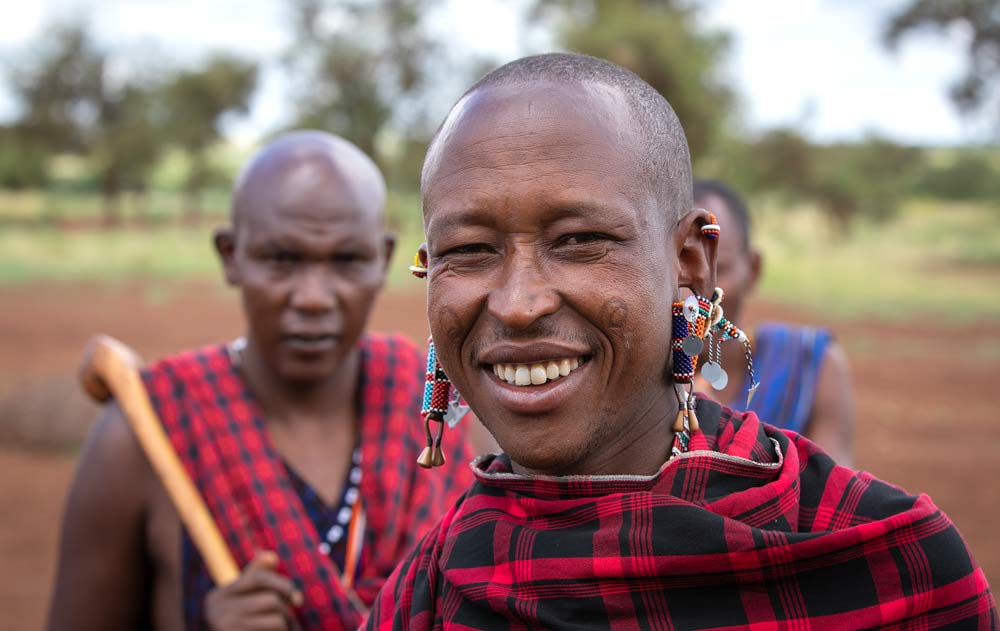
A group of young men wait by a break in the fence. They’re dressed in traditional Maasai costume – red, plaid, shuka cloaks, simple sandals made from old car tyres, known as ‘thousand milers’, strings of beads wound around their chests. Our driver calls out a greeting and the young men approach to welcome us. Their English is perfect; their smiles are wide.
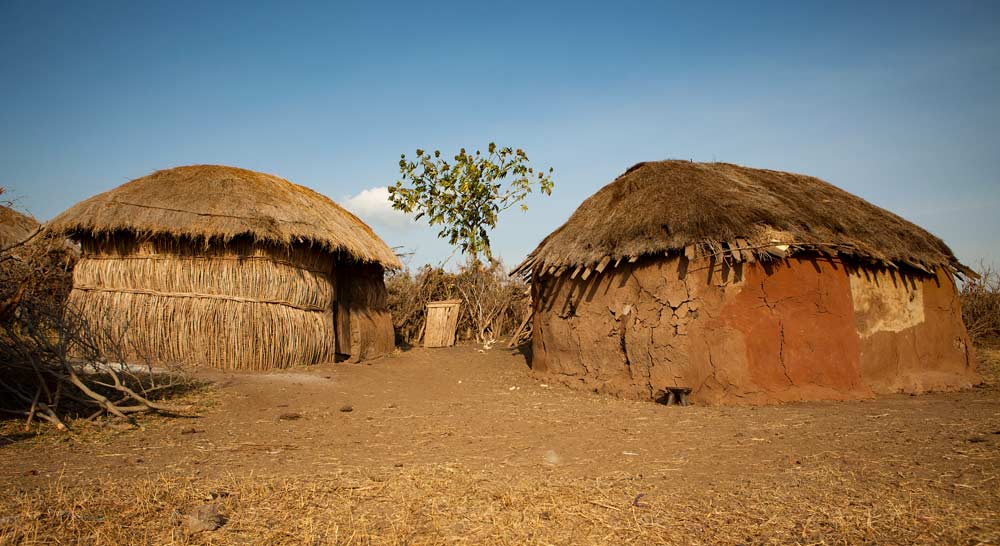
We move on into the village or boma (enclosure). It’s a large circular enclosure containing a central area of bare mud. Around the perimeter are perhaps eight or nine low huts with mud walls and flat brushwood roofs. A few scantily clad children peep around corners – eyes large. A yellow dog with a curled tail sleeps in the sun.
We meet the villagers
We are introduced to the chief of the village and now, as if beckoned by some unseen signal, people emerge. Women cradling babies, old men leaning on long sticks. But there are no warriors and no younger women. The reason soon becomes apparent – they have been getting into their dance costumes.
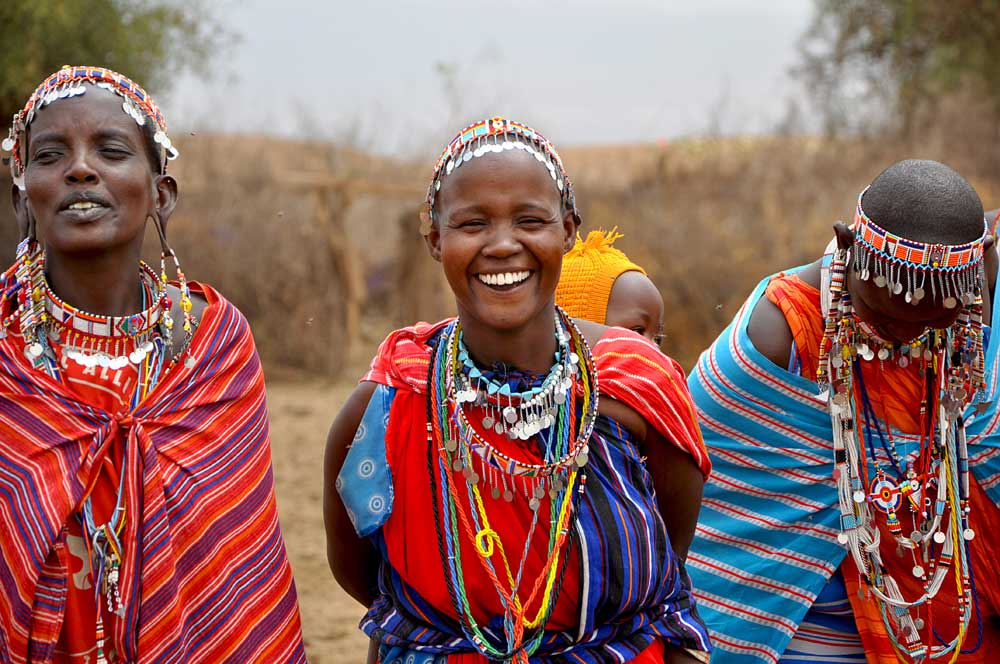
The warriors approach in a long line, their heads dipping as they pace rhythmically forward raising and lowering their spears as they come.
And then the dance begins. In the centre of the boma , the maidens sing, their voices high-pitched, reed-like and surprisingly loud. They move in a stamping, swaying dance – like so many brilliantly coloured butterflies.
Maasai jumping
The young men take the stage. Their song is deep and reverberating. They form a semicircle and one by one, step forward and jump high into the air. It’s uncanny just how HIGH they can jump. ‘The current Maasai record is eight feet’, says our guide as an aside.
Naturally, we’re encouraged to have a go ourselves.

Bartering for beadwork
Almost as quickly as it began, the dance ends, and the colourful crowd moves off. ‘Now to the market,’ says our guide. Beyond the rough fencing of the boma , a makeshift market has been set up – and here the people from the surrounding bomas have set up their display.
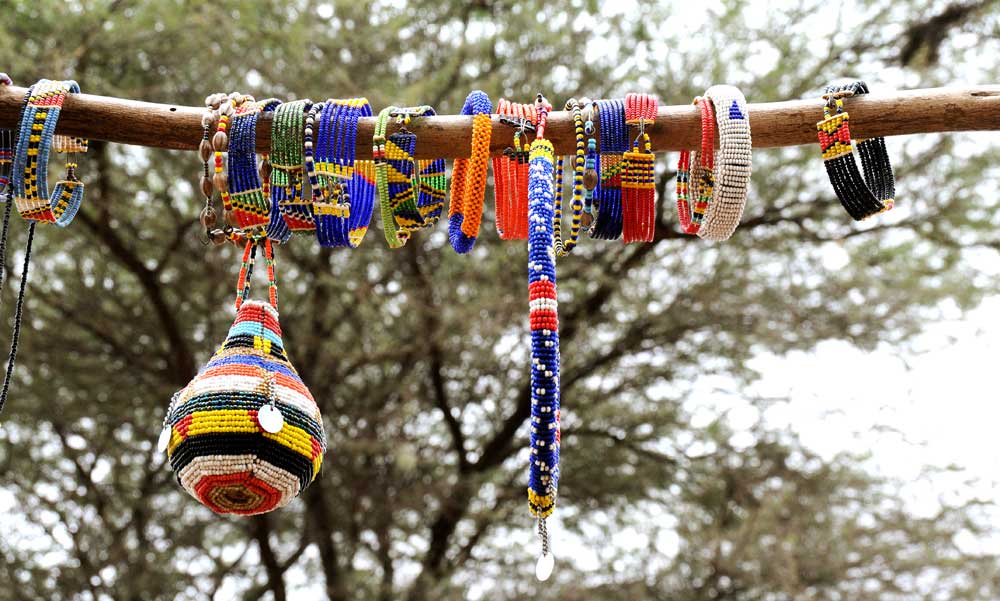
Some ladies sit on the ground, others have simple stalls – and the display of beadwork is stunning. There are necklaces and collars, beaded walking sticks and beaded belts. Every lady strives to thrust her own wares forward. It’s utterly chaotic and superbly colourful. Cameras whirr. The ladies don’t speak English so the chief translates. We’re expected to barter and, though timid at first, we enter into the swing of things. Finally, laden with belts, beads, shields, gourds and fly-whisks we return to our vehicle. But we’re not alone. We’re escorted by the ladies, the dancers, the warriors, the toddling children and the yellow dog.
A Maasai village visit is an experience and a privilege
Reluctantly we depart. We’re silent in the vehicle. Absorbing it all. For perhaps 45 minutes we have been welcomed into another realm – one so entirely unlike our own that we are simultaneously humbled and uplifted. It’s an experience and a privilege. And one certainly not to be missed.
Leave a Comment Cancel Reply
Save my name, email, and website in this browser for the next time I comment.
Kenya Holidays
Get in touch
Make a booking
© 2024 Kenya Holidays
- TRAVEL JOURNAL
- Write for Traveler’s Buddy
- Media content
- Video Content
- Photography and Video content
How to plan the best safari in Masai Mara in Kenya
Itineraries, transportation, accommodation, safari prices, and best time to go. This is the best guide on how to plan the perfect safari in Masai Mara in Kenya.
Think about a perfect safari experience and you will probably end up imagining a safari in Masai Mara in Kenya. This world-renowned national reserve is not only Kenya’s biggest pride, but is also one of the most beautiful places in the world. Expect to see vast grasslands where more than 1 million zebras and wildebeest roam freely, herds of elephants drinking water next to water buffalos and if you are patient enough, lions, cheetahs and leopards quietly searching for a hunt.
Visiting Kenya without exploring Masai Mara is missing something special, and with so many wild experiences to look for, options to move around the park and prices that go from just a couple of hundreds of dollars to even thousands per day. Even so, it is important to understand what makes Masai Mara so special and how to make the most of your time and money. This is how you plan the best safari in the Masai Mara National Reserve in Kenya.
Understanding Masai Mara
Known as “the greater Masai Mara ecosystem” , this large ecosystem consists of two natural reservoirs ( Mara Triangle and Masai Mara National Reserve ), several smaller private conservancies and some Masai villages around the parks. They are located 255km south-west from Nairobi (about 5-6 hours’ drive) and right next to the border between Tanzania and Kenya. In fact, Masai Mara limits the Serengeti National Park and you can even say they belong to the same ecosystem, just in a different country.
Before you visit Masai Mara, take into consideration how many days you want to spend inside the national reserve, where would you like to stay and what kind of activities are you planning to do. These decisions will significantly have an effect on how expensive your trip to Masai Mara will be.
Still, no matter if you are going on a group tour, a private safari or as an independent self-driving traveler, it is nice to understand the options you have.
Read more: Tsavo, Amboseli or Masai Mara – Which safari park in Kenya should you visit?
Masai Mara National Reserve
This is the largest section of the Masai Mara and home for the largest concentration of animals in the park. It is basically an obligatory stop if you want to explore the best of Masai Mara and no matter at what time of the year you go, it will never get boring.
Expect to see large concentrations of wildebeest, zebras, elephants and lions.
Mara Triangle
Located in the west side of the Masai Mara and isolated from the rest of the park by the Mara river, the Mara Triangle is considered by many safari experts as the most beautiful spot in the whole Masai Mara. “The Mara Triangle is what makes Africa the most beautiful continent on earth”, said my tour guide Chris, after I asked him what makes the Mara Triangle so special.
Here is the perfect spots to see less crowds of tourists, but also thousands of wildebeest taking a rest and waiting for the right moment to continue their migration.
Private conservancies
Private conservancies are usually owned by private luxury lodges. These are unfortunately not places you can simply get in and out, as you would have to pre-book a visit to any of the conservancies or stay at the lodges.
A visit to a private conservancy can be on one side very rewarding – they usually know better where to find big cats – but also way more expensive. It is the perfect option for those who want to splurge themselves on a holiday.
Take into consideration, visiting a conservancy does not mean you will see more wildlife than in the national reserve.
Keep in mind
Just like in most national parks in Africa, entrance fees will be the highest cost when planning a trip. While the 24 hour day pass to the Masai Mara National Reserve cost 70 USD per day, visiting the Mara Triangle conservation area will cost additionally 40 USD and visit a private conservancy can start at around 100 USD per day.
Check all prices at the official sites of the Mara Triangle , the Masai Mara National Reserve and the Mara Conservancies.
NOTE: Travelers with limited time and higher budget can also get a private charter from Nairobi airport to Masai Mara. Flights can be schedule regularly during the day from Wilson Airport in central Nairobi and it can take you from Nairobi to Masai Mara in just 30-45 minutes for around 200 USD. Before booking a private flight , consult with your tour operator or lodge the fly-in safari tours they might offer.
Best places to stay in Masai Mara
With entrance fees to Masai Mara being your highest expense, and transportation costs being quite fix from the beginning, accommodation will determine if you are getting a more luxurious or budget experience in your safari.
It is true that if you check on hotel booking platforms, you will probably see lodges inside Masai Mara starting at hundreds of dollars. But don’t worry. Most of these accommodation options include some kind of activity that you can also get on a private tour or organize yourself.
Masai Mara is one of the best national parks in Africa, when it comes to finding accommodation under your desired budget. Options are plenty and no matter if you go on a budget or stay in a villa with a private pool, the quality of the safari experience will be almost the same.
Read more: How to plan a visit to Amboseli National Park
With only three options available, public campsites are only located on the Mara Triangle side of the park with prices starting at 30 USD a night. Furthermore, 5 private campsites are also located inside the Mara triangle. Prices for these camps tend to be more expensive, but facilities and services are way better. From private campsites you can also schedule walking safaris or drives around the national park
Camping options and prices are available at the official website of Mara Bookings
Lodging outside the national park
An excellent option for keeping that budget under control is staying outside the national park. Don’t worry, sleeping outside the park does not mean staying out of the action. The towns of Talek, Keekorok or Kawai are located right next to the gates of Masai Mara and here you can find accommodation for more than 1/3 of the price as inside the national reserve.
What are the disadvantages? There is nothing more exciting and simultaneously scary as hearing lions roar in the middle of the night – something that is only possible if you stay inside the gates of the national reserve.
Lodging inside the national park
With most world-renowned lodge companies and luxury companies having accommodation options inside Masai Mara, here you can also have plenty of choice and pricing. Unfortunately, due to its outstanding location, expect prices to be way higher – a price to pay for a more rewarding experience. Lodges inside the Masai Mara National Reserve start at 150-200 USD a night per person.
Staying inside Masai Mara is an experience like no other. Hear baboons grunt in the early morning or lions roar in the middle of the night. If camping is not your cup of tea and you want to make the most of your experience in Masai Mara, this can be the right option for you.
Lodging in a private conservancy
With private airstrips and facilities that exceed the imagination, lodging in a private conservancy is an experience of a lifetime. Four seasons, Fairmont and &Beyond are some of the companies that have turn safari experiences into playgrounds for adults.
Expect to be welcome with cocktails and smoothies, or simply getting woke up with a glass of ice coffee. At the same time, be prepared to spend at least a couple of thousand of dollars just for a few days.
NOTE: If you are planning to stay on a mid-range or a luxurious lodge, it is way better to plan your trip with a private local tour operator. Tour operators get better rates than private clients when booking accommodation and even though you have to book a full package including a driver and game drives, it will end up being way cheaper than planning it independently.
Other activities in Masai Mara
Doing 3-4 full days of safari in Masai Mara is not an activity for everyone. After hours of driving around the natural areas, landscapes can become monotonous and the excitement of seeing an elephant or a lion is not there anymore. I’m not saying it happens all the time, but anyone who has done a safari before knows what I’m talking about.
Fortunately there are lots of additional activities to do in Masai Mara. One of the most popular and recommended ones is a tour to a Masai village.
Read more: Everything You Need To Know About The Wildebeest Migration
These villages are located outside the natural reserve. Here, local Masai will tell you more about their culture, their traditions and how they used to live decades before globalization. You can also see some of the craft that the local families make, as well ask them questions about life as a Masai in the current age and their villages.
Some people complaint that most of these Masai do these activities for the money it provides and the experience is not “real”. However, everyone benefits from these cultural tours. We, by having more awareness about the disappearing Masai and them by earning the money they need to offer their families a better future.
Other options are walking safaris organized by the lodges (around 20-30 USD), as well balloon rides early in the morning (around 350 USD).
Read more: How ethical is to do cultural tourism in Africa?
Best time to visit Masai Mara
What is the best time to visit the Masai Mara? Well, this question can be quite open, as most of us plan a trip based on the budget and the experience we want to get.
Masai Mara is known for having excellent wildlife experiences all year round. However, most wildlife lovers agree that the best time to visit Masai Mara is during the wildebeest migration (mid-June to October). During this time, millions of wildebeest move from Kenya to Tanzania crossing the Mara river. This gives a great opportunity for encountering some of the wildest safari experiences in the world. At the same time, expect prices to almost double for safari tours and lodging to be booked months in advanced.
Additionally, November to February is still considered high season. Prices are not as high as during the migration, but still you can see plenty of wildlife.
March til May are on the other hand a low season. Grass is high due to the heavy rain and visibility is limited. Predators do not have difficulty to hunt and they can easily hide. Still, prices are way lower during this season and the chances to see all big five in a single trip is still there.
Read more: What are the top safari experiences in Africa
Group tour, private tour or self-drive safaris
Any type of safari in Masai Mara is already a big expense. Safaris in Masai Mara are considered one of the most expensive experiences worldwide and considering which option is the one with most value is a very valid question when planning a visit to Masai Mara.
While group tours offer a very budget friendly option for travelers who want to focus on saving money, take into consideration that you will be traveling with lots of people (around 6-8 on a van). This will significantly affect how personal your experience in Masai Mara will be, as well the flexibility of the whole trip itself.
On the other hand independently driving to Masai Mara will give you all the flexibility you want, but zero knowledge of where you are going. Self-driving in Masai Mara means driving in very difficult conditions and budget wise, it won’t be cheaper than traveling with a tour.
Insurance costs, rental costs and park fees will be quite high if you travel to Masai Mara as a self-driver and unless you have a good understanding of wildlife and the Masai Mara itself, the chances of seeing big cats, will be quite small.
I personally found going on a private company the best option for visiting Masai Mara. Private operators adapt very easily to your budget conditions and offer the flexibility you simply can’t get on a group tour. It is definitely more expensive than going on a group, but I think it gave me way more value, than if I visited Masai Mara in a van full of people, or if I rented a vehicle and drove myself.
I booked my trip with Africa Kenya Safaris , a local company based in Nairobi. Before our trip, we discussed exactly what I wanted to explore and in what budget I was traveling. Since they also know all the lodges and camping sites, they could also analyze for me which ones would be the best according what I wanted and offered a good price. After comparing the prices of planning a trip independently or separately, this was the best value I could find.
NOTE: While foreign tour operators seem on their online presence to be most trustful than local companies in Kenya, getting in contact with a Kenyan company is the best way to get the best knowledge and value out of your tour.
Read more: How to prepare for your first safari trip
How much a safari in Masai Mara costs?
With so many variables and options, it is really difficult to fully calculate how expensive a safari to Masai Mara can be. Still, if you are planning to travel to Masai Mara on a budget, expect to spend around 600-700 USD for a four day tour in low season.
Furthermore, if you are staying in a mid-range lodge with all meals and private games drives included, plan anything between 800-1000 USD per person for a 2 person private safari.
Read more: How to plan a trip to Serengeti National Park in Tanzania
What type of safari in Masai Mara should I book?
A budget safari can be fun, but you have to keep in mind that you will have to share vehicle, have less privacy and end up having less time.
Still, if the budget is a big concern for you. These are the best Masai Mara Tours under 400 USD in SafariBookings
If you are looking for a more private mid-range experience, you can also find private tours for a higher budget, but offering a more memorable trip. A mid range tour cost anything between 700 to 1200 USD and in these tours you will get a private safari vehicle, better lodging (4-star) and better guidance.
Finally, if budget is not a question and you want to experience Africa like the rich and famous, luxury tours start around 1500 USD per person for 3 days at Masai Mara and can go up to thousands more.
In SafariBookings , you can get in touch with operators from all over Kenya and create personalized tours directly with the top tour operators in the region
How would I plan my next trip to Masai Mara?
After getting a good glimpse of Masai Mara and try different activities, lodges and traveling options, I would plan my next trip mid-October or beginning November. It is a time when conditions are excellent for wildlife viewing and additionally, there are still large chances of seeing thousands of wildebeest crossing.
At these months, you would not encounter as many visitors as in other times like Summer or Christmas and because the peak season is almost ending, prices are lower and offers can be easily found.
Read more: How to cross overland from Kenya to Tanzania
How to book the best safari online?
When it comes to planning a safari, SafariBookings is by far the best platform to book safaris online
They have the largest database of tour operators in Africa and you can simply send a request and negotiate a tour and a price directly with the operator. You don’t have to pay any additional fees and you can send as many requests as you want.
I’ve used SafariBookings when traveling to Mozambique, Namibia, Zambia, Zimbabwe and Kenya. They made a huge difference for me in understanding prices, activities and local operators in the area. I was also able to find tours for as little as 300 USD when I traveled to Amboseli National Park in 2021.
These are some of the most popular tours in Masai Mara at SafariBookings
How do I find cheap flights to Kenya?
Finding a cheap flight anywhere around the world is not always easy. It’s about comparing platforms, selecting the right routes and booking at the right time. Fortunately, platforms like Skyscanner became known as an all-in-one tool for booking flights at the lowest cost possible.
They analyse every potential company and sub-contractor in order to find the lowest price available for you. Not only that, but you can also select the option “Travel Anywhere” and let Skyscanner find the cheapest place to travel at any selected date.
I check all my flights first at Skyscanner , and in 90% of the cases, I find the best option for me to book.
Also, by booking here using Skyscanner , you will support my blog and help me create more amazing and useful content.
MY FAVORITE NATIONAL PARKS
Saxon switzerland national park, masai mara natural reserve, bwindi impenetrable forest, white desert protected area, victoria falls national park.
How To Spend 3 Days In Masai Mara, The Safari Park From The Lion King
This Kenyan national park is one of the best places in the world to see lions, leopards, and cheetahs in the wild.
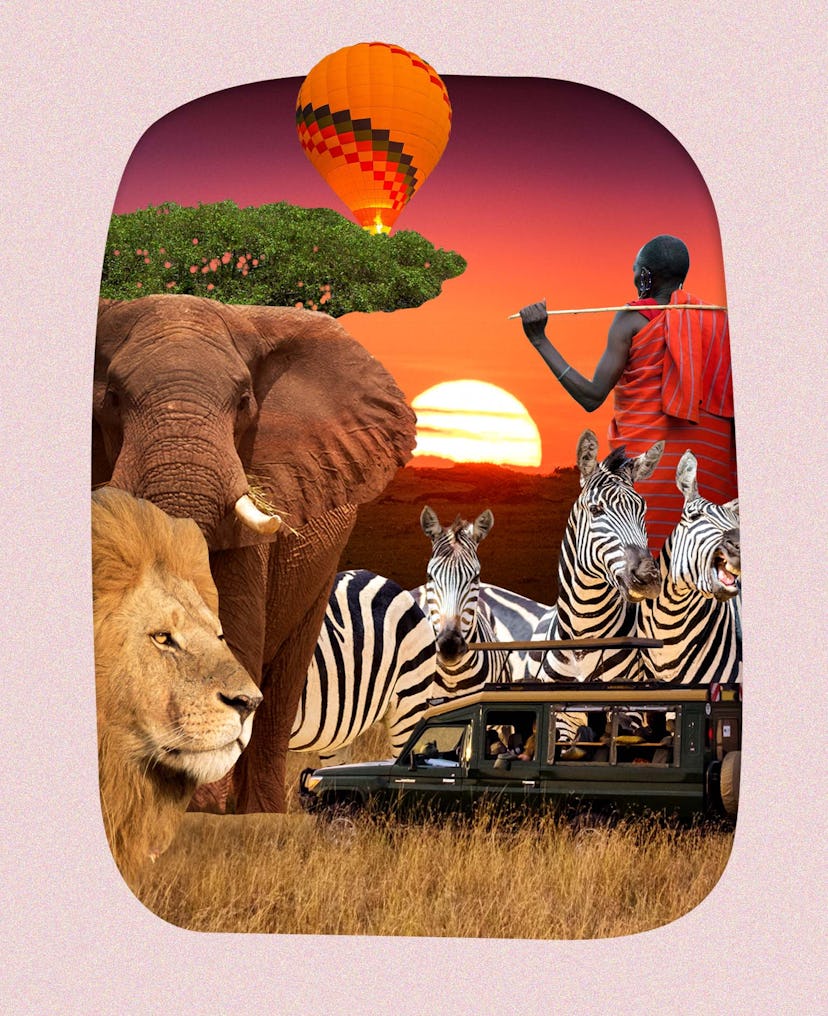
When it comes to planning an African safari , TikTok can agree on one thing: Masai Mara National Reserve in Kenya needs to be on your itinerary.
“The Land of the Big Cats” has a reputation as one of the best places on the continent to see lions, leopards, and cheetahs in the wild; it was one of the main filming locations of the live-action Lion King movie .
Masai Mara’s location in the Great Rift Valley gives it a leg up on wildlife diversity compared to other reserves. Its 580 miles of lush savannah is home to almost 90 different mammal species, and safari-goers have a good chance of spotting all of the African “Big Five” — lions, leopards, elephants, African buffalo, and the elusive black rhinos — as well as members of the slightly lesser-known (but equally ‘Gram-worthy) so-called “Ugly Five,” hyenas and warthogs included. If you visit in late summer, you might even see the Great Migration of over 2 million wildebeests, zebras, and other herbivores crossing the Mara River from the neighboring Serengeti Desert.
This February, I spent 10 days visiting Kenya’s national parks and game reserves on an itinerary curated by EF Ultimate Break , a Gen Z and millennial tour company. After a week of bush glamping in sparsely vegetated and dusty parks throughout Kenya, Masai Mara was comparatively lush, and my safari Jeep was constantly stumbling upon families of elephants, giraffes, and lions.
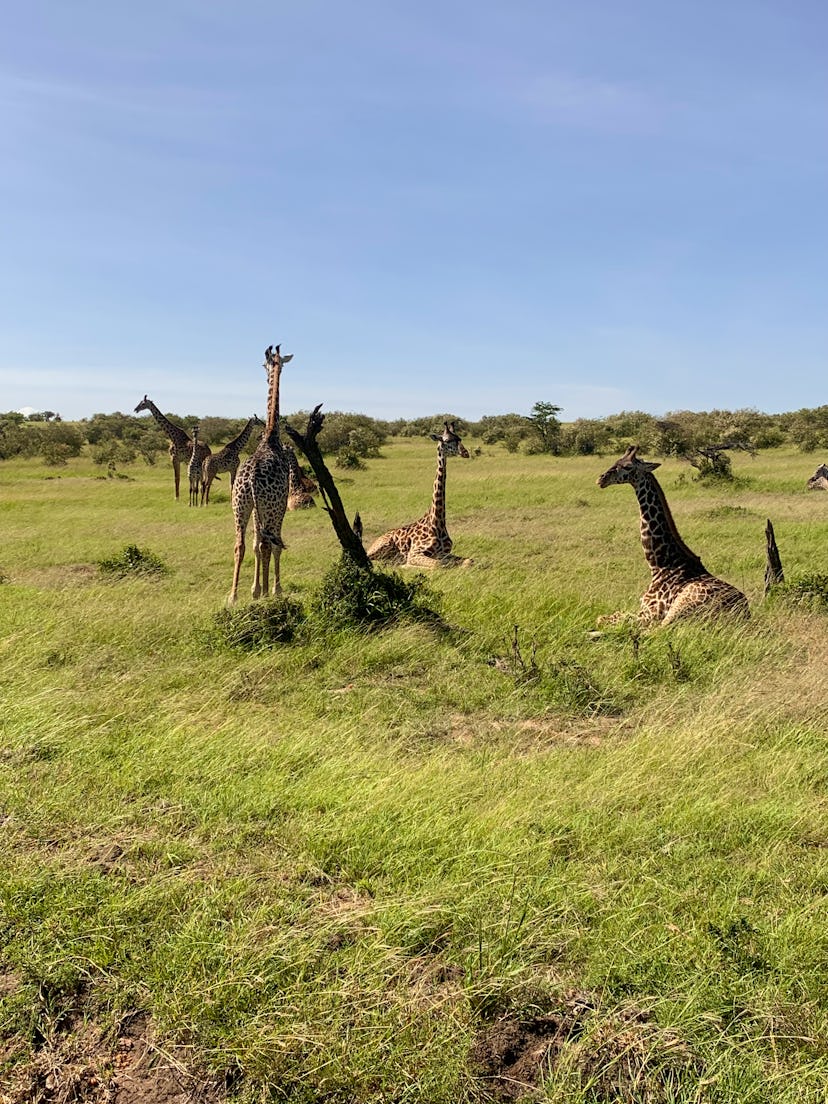
If you’re heading to Kenya on safari soon or scrolling TikTok for future inspiration , here’s what’s worth doing at Masai Mara and how to spend three days at the reserve.
What To Do At Masai Mara
Day 1: hang out with baby elephants & meet the maasai tribe.
After a 20-plus-hour journey from Chicago, I stretched my legs at one of Nairobi’s most popular attractions. The Sheldrick Wildlife Trust’s Orphans Project houses baby elephants and rhinos who are currently unable to survive in the wild for whatever reason, and it’s just as cute as you’d expect. There was a collective “aw” as the tiniest baby black rhino stumbled out to meet the crowd, and we got introduced to all the baby elephants as they clumsily ran to the keepers for their bottles of milk.
The experience was more crowded and touristy than I expected, but I enjoyed learning the story behind each baby animal, seeing their personalities, and petting them. You’re also able to sponsor one of the baby elephants or rhinos until they’re ready to go back into the wild.
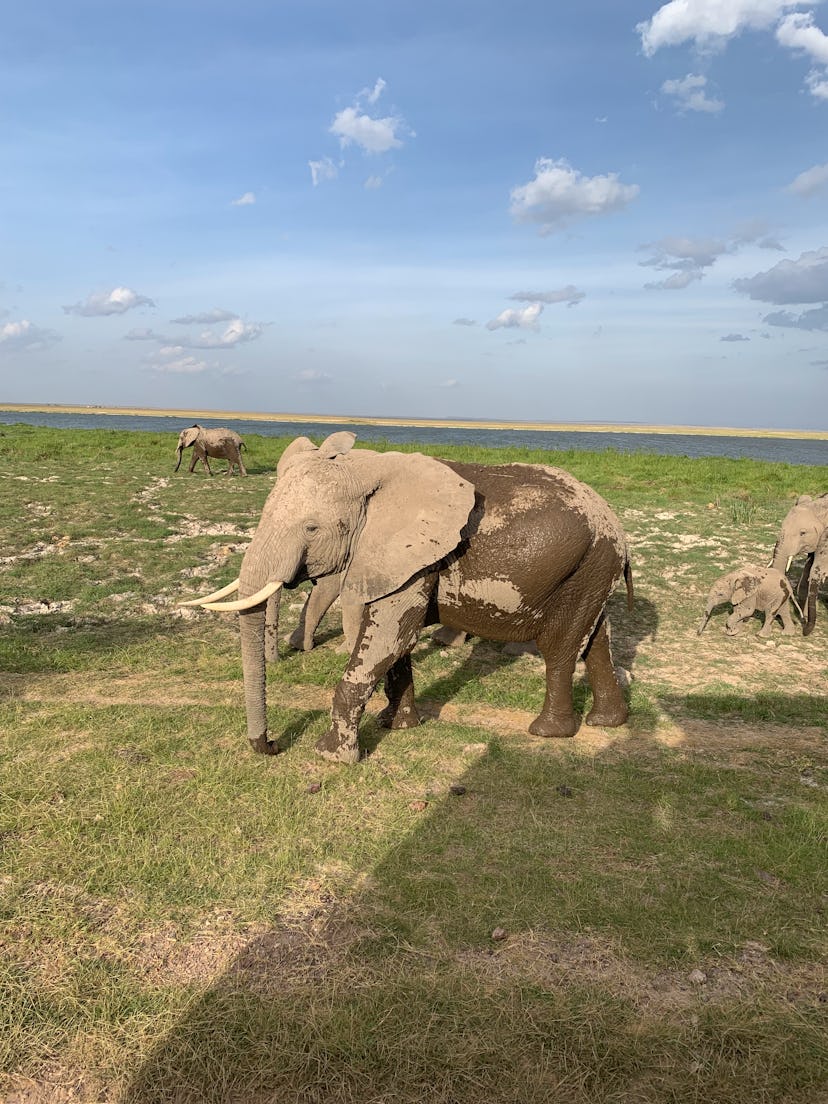
After hanging out with the animals, get into your safari Jeep to drive the five hours to Masai Mara. I stayed at PrideInn Mara Camp, which had glamping tents and cottages just steps from the park and Lake Talek, but there are plenty of accommodations around Masai Mara’s perimeter (including regular hotels like a JW Marriott Masai Mara if sleeping in a tent without air conditioning isn’t your vibe).
The best part of the PrideInn Mara Camp (and others in the area) is the presence of the Maasai tribe , which welcomed us with a traditional song and dance. There were also a number of warriors who worked in the hotel and who would walk us to and from our rooms if it was late at night.
Day 2: Take A Hot Air Balloon & A Drive
The park is huge, so soaring over the savannah to see the landscape and animals from above is an efficient and bucket list-worthy way to start off your safari experience.
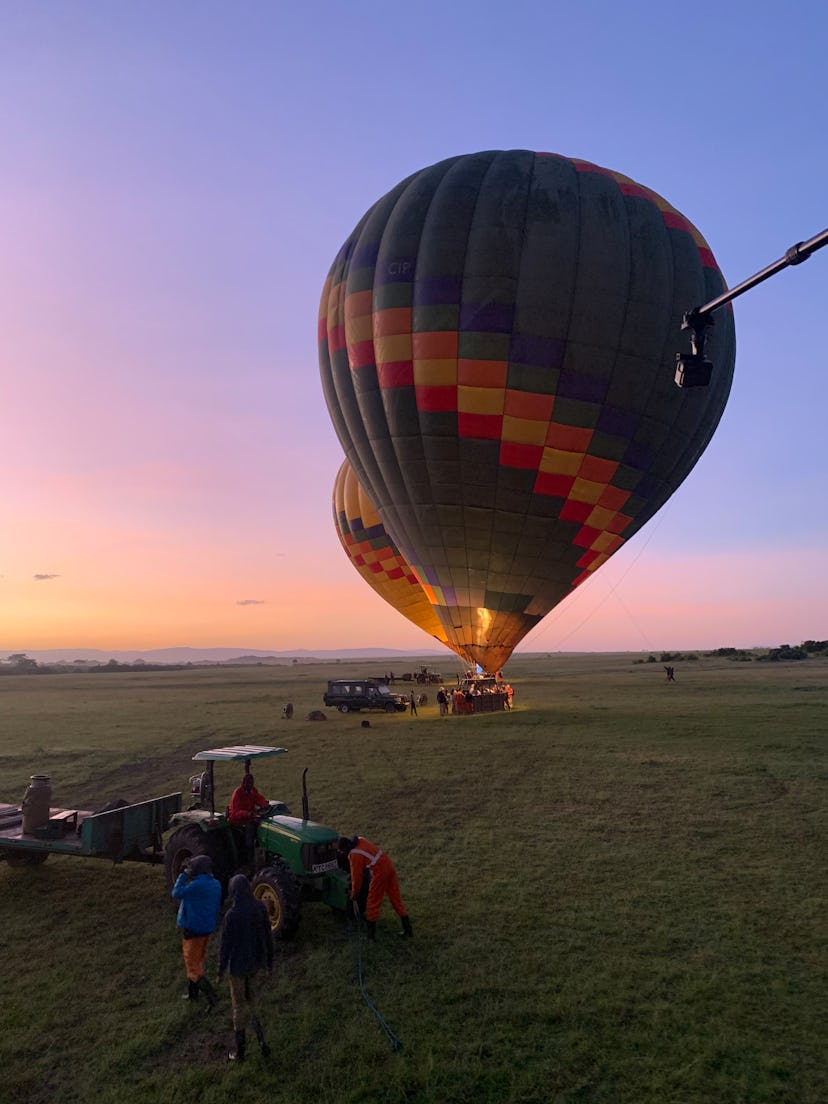
We had to wake up at 4 a.m. to head over to the hot air balloon launch site, but I quickly stopped complaining about the early call time when we were in the balloon and the sun was rising over Masai Mara.
We got to take in bird's eye views of the Mara River (including a rare sighting of an adorable baby hippo that was splashing through it), check out a family of grazing giraffes from above, and get eye-level with the vultures in the trees. Afterward, we enjoyed an English-style brunch with unlimited mimosas in the middle of the bush, then headed back to the camp to nap it all off.
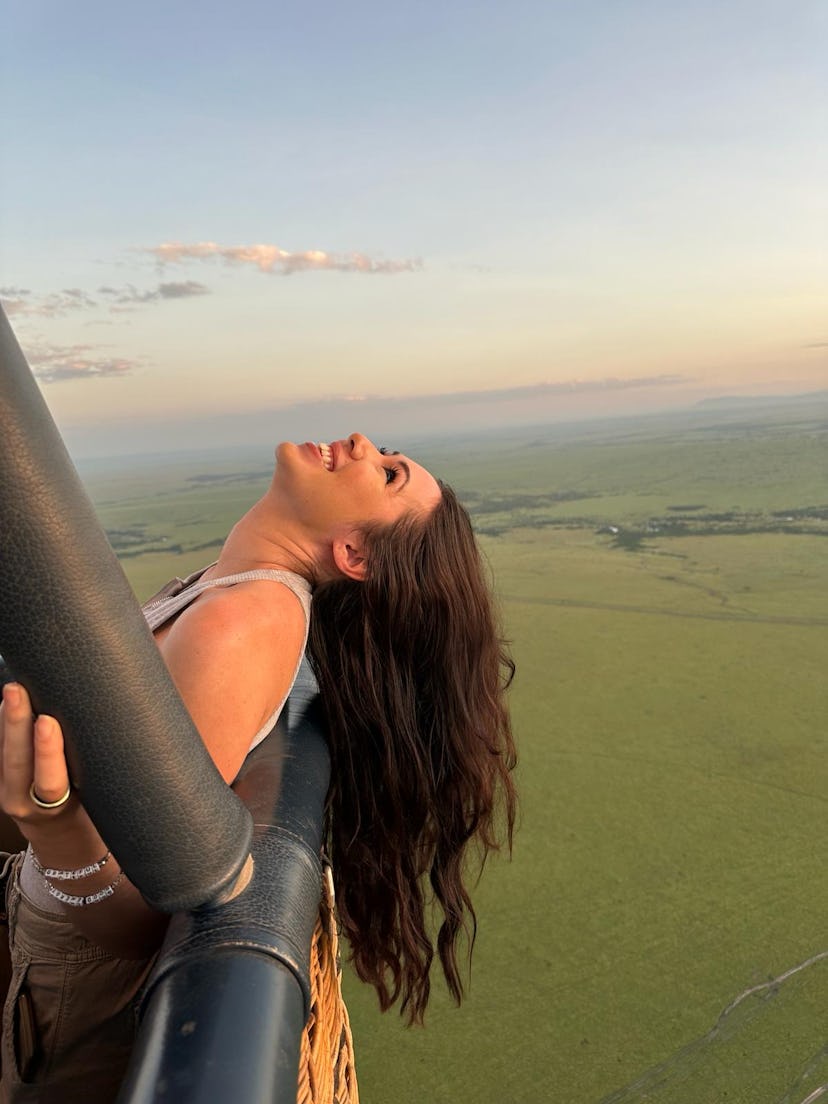
In the early afternoon, we headed on our second safari and stayed until twilight. After spending almost two weeks in Kenya, I realized it’s 100% worth doing two safari drives a day — one in the morning as the sun rises and one at dusk right before the predators are about to start hunting — to get the fullest picture of how the animals act in their natural habitat.
Depending on the time of day, you’ll also see different personalities from the lions. When I went in the morning, the lions weren’t the apex predators I’d anticipated. Instead, the pride was almost playful, with a young male lion with a dandelion mane nuzzling his father and the female lions, and cuddling with them in the sun. The only hint of their agility and quick reflexes were shown in how they quickly flipped from side to side and how alert they seemed at all times, with their heads suddenly popping above the grass when they’d been lazily napping in the sun just moments earlier.

Another day, as the sun went down, I saw a group of lionesses who’d been napping and were barely camouflaged in the long grass start to oh-so-casually make their move. They inched toward a grazing herd of wildebeests, their eyes locked on their next meal. I wouldn’t have experienced these different personalities if I hadn’t seen both in action.
Day 3: Go On A Morning Game Drive & Visit The Maasai Tribe
After going on a sunrise game drive, take an afternoon tour of the Maasai tribe’s village. Dressed in signature bright red robes, the warriors greeted us at the entrance of their village. They taught us some of their chants and performed a 10-minute celebratory song and dance that we were encouraged to take part in, which included mimicking the roaring of lions, shaking our shoulders, and competing to see who could jump the highest.
Then, they sectioned us off into groups to tour the family huts and learn about their pastoral lifestyle. Many of the Maasai people have gone into tourism and are employed by hotels and other hospitality businesses in the area, but they’re one of the few tribes where many members still practice their traditional way of life.
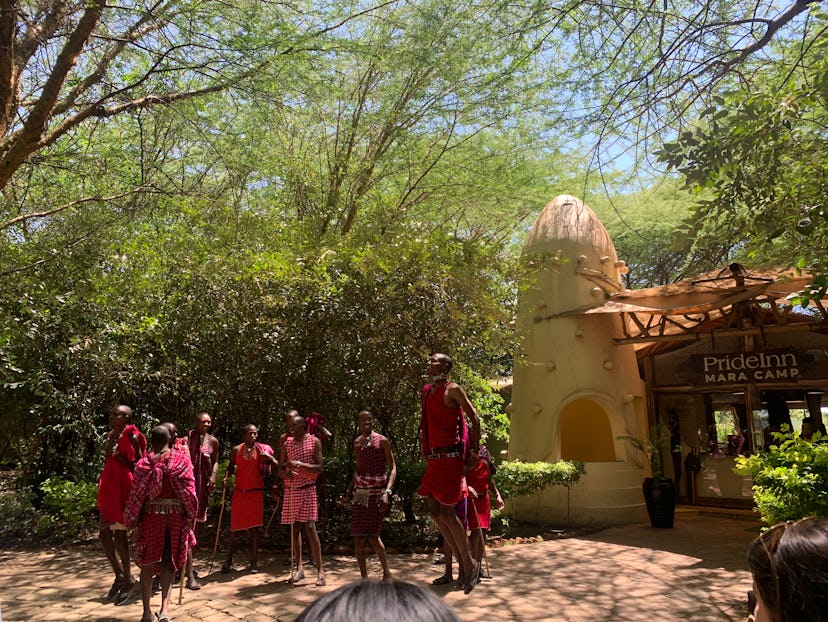
After the tour, we got to shop the tribe’s gorgeous beadwork, carved wooden products, and other souvenirs. I picked up a blue bracelet, a beaded choker, and some wooden coasters painted with safari animals to bring back home with me.
Ultimately, I came back to Chicago feeling relaxed, inspired, and fully ready to take advantage of my apartment’s air conditioning. I gained a deep appreciation for my proximity to wildlife during my bush glamping adventure (yes, even for the crickets and lizards in my tent).
Going on safari was life-changing for so many reasons. I was awestruck by seeing a 3-day-old hippo hanging out with his mom, and a pack of elephants racing across the savannah. I was surprised that the lions and giraffes seemed to barely take notice of our Jeep.
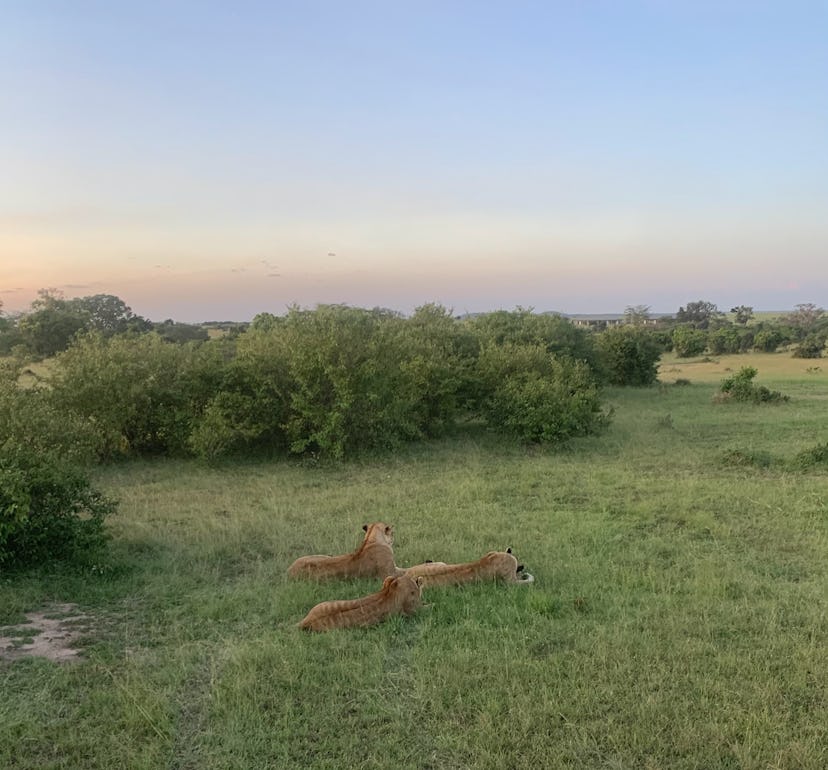
The safari also taught me a lesson in patience. Unlike in a zoo, you’re not able to control when or where you’ll see cheetahs, hippos, or prides of lions — which ends up making it so much more fulfilling when you do.
It’s not a question of if, but when, I’ll go back to Masai Mara on safari. And who knows — maybe this time I’ll spend more than a few days exploring Kenya’s most famous game reserve.

IMAGES
VIDEO
COMMENTS
The Maasai village visit is typically an excursion included into a longer multi day Masai Mara safari tour, and couple of hours are set apart for this brief interactive visit to the village, which usually happens to be on the fringes of the main Mara game reserve boundaries. Many tourists wish to know how much it costs to visit a Maasai village.
A visit to a Maasai village is almost inevitable when travelling to the Maasai Mara. The Maasai (or Masai) are mostly known for the colourful garments and jewellery they wear, their warriors and high jumps, which continue to fascinate tourists. The Maasai is one of the 43 tribes that make up Kenya's population, but it can also be found in ...
Visiting a Maasai village can be arranged through the camp where you are staying in the Mara, through your tour operator, or arranged with your driver-guide if you're hiring your own guide. The price for visiting a village ranges from $25 to $50 per person and is viewed as a contribution to the village. A typical visit last about two hours.
Join us on an unforgettable journey. Tour the Masaai Mara Village, stay a night or two, or go on a safari adventure in the Mara with a Maasai guide. Location: Sekenani just 800 meters from Sekenani main gate on your way to Oloolaimutia Gate, Masai Mara, Kenya. Email: [email protected]. Tel: +0719125853.
The Masai Mara is a dream come true for everyone who ever watched 'Out of Africa' and longed for the adventurous, romantic nostalgia of an African safari in the wild. ... Add a visit to a Maasai village to your stay for a cultural immersion and gain some insight in the day-to-day life of your hosts. For an extra special birds-eye view of ...
What to Know Before a Visit to Maasai Village in Tanzania. Meeting Maasai tribes is on many people's bucket list after seeing photos of Maasai warriors jumping high in the air, with the African savanna as their backdrop. Most safari companies offer a stop in a Maasai village in Ngorongoro Crater, promising a wonderful experience.
Masai Mara National Park. Maasai cultural visit. Immerse yourself in authentic Maasai culture as you visit a traditional village, accompanied by an English-speaking guide who lives there himself. Find yourself in the midst of the daily hustle and bustle of local life as you witness the daily rituals of the Maasai. Once you have drunk your fill ...
Discover the Maasai Village: Our authentic travel experience takes you beyond the wildlife encounters of the Masai Mara, offering a unique opportunity to visit a Maasai village and connect with its residents. Step into their world, witness their daily life, and gain a deeper understanding of their traditions, customs, and way of life.
Masai Mara. Kenya, Africa. Dream of Africa and chances are that you dream of the Masai Mara. This huge expanse of gently rolling grassland - specked with flat-topped acacia trees and trampled by massive herds of zebras and wildebeest - is the ultimate African cliché. But for once the reality lives up to the image and the Masai Mara, which ...
The Masai Mara is a relatively small reserve, covering an area of approximately 580 square miles in southwest Kenya. Its southern boundary marks the Kenya-Tanzania border and the beginning of the Serengeti; while the remaining boundaries are adjoined by private conservancies. These conservancies are owned by tribal communities and managed by ...
A visit to Masai Mara National Reserve is the quintessential safari experience in Kenya. Read this safari guide to the Masai Mara to learn more. ... Activities: Bush Walks, Game Drives, Birding, Fly Camp, Hot Air Balloon Flight, Night Game Drives, Sundowners, Visit Masai Village, Swimming Pool, Canvas Bush Bath; Avg. Price: $2,000 - $2,500 ...
The Masai Mara is one of Africa's top wildlife destinations and Kenya's flagship conservation area. It offers excellent year-round game viewing thanks to its diverse population of game like elephant, buffalo, zebra, giraffe, hyena, eland, gazelle, and the Mara's famous big cats. Finding lions with Naibor Camp.
Embrace the African culture. When you book your tour to the Masai Mara, Amboseli, or Samburu Park, just let us know if you would enjoy a side adventure to visit a local village. The cost is just $20 per person and payable to the village chief. While on safari you can also let your guide know you'd like to make a detour to visit a local ...
2. Maasai Villages in the Aitong Region. Exploring the Maasai Villages in the Aitong Region is a captivating journey into the heart of the Maasai Mara. It offers a glimpse into the vibrant culture and traditions of the Maasai people. These villages, or manyattas, are a testament to the resilience and spirit of the Maasai, who have maintained their way of life amidst the changing landscapes of ...
This one hour visit to a Maasai village is a chance to interact with the Maasai and get a glimpse into their culture, unique way of life and see first hand some of their customs and practices. The Maasai village visit is typically an excursion included into a longer multi day Serengeti safari tour, and couple of hours are set apart for this ...
The Maasai Mara National Reserve is a breathtaking wildlife sanctuary located in the Narok County of Kenya. Named after the Maasai people, the area's indigenous inhabitants, and the Mara River which divides it, this reserve is globally renowned for its exceptional wildlife population, picturesque landscapes, and unique cultural experiences.
The Maasai Tribe: What a Visit is Really Like. Written By: The Planet D. Tanzania. Updated On: December 20, 2021. A visit to a Maasai tribe is a popular stop on nearly every safari you'll take through Tanzania and Kenya. After all, it is the "must-see" tribe to see when going to the Serengeti or Masai Mara. Table of Contents.
A village visit opens the door on a unique way of life and set of traditions. Your ranger will drive you to the village where Masai warriors and women ceremoniously receive you as a respected visitor. Having been introduced, a Masai host will give you a tour of the manyatta, explaining the lifestyle and what lies inside one of the huts.
Maasai warriors participate in an adumu, or as it is known by western visitors, the Maasai jumping dance. The men get into a circle and begin a call-and-answer chant. Each male enters the circle ...
A Maasai village visit. One of the highlights of a visit to Kenya is the chance of experiencing an authentic Maasai village visit. Such visits will generally be arranged by your tour guide or lodge and are well worth doing. This feature aims to give you an idea what to expect of your visit. Once outside the boundaries of the Masai Mara National ...
Still, if you are planning to travel to Masai Mara on a budget, expect to spend around 600-700 USD for a four day tour in low season. Furthermore, if you are staying in a mid-range lodge with all meals and private games drives included, plan anything between 800-1000 USD per person for a 2 person private safari.
Masai Mara's location in the Great Rift Valley gives it a leg up on wildlife diversity compared to other reserves. Its 580 miles of lush savannah is home to almost 90 different mammal species ...
Home > Kenya Safaris > Maasai Village Visit. Maasai Village Visit. Photo Credit - Sarah.Ahearn East Africa is home to several African Tribes, of which the most famous surely are the Maasai. This nomadic, warrior tribe which once held vast swathes of pre colonial Kenya, still retain many of their traditions as they live largely unaffected by modern day civilization, in areas surrounding Masai Mara.